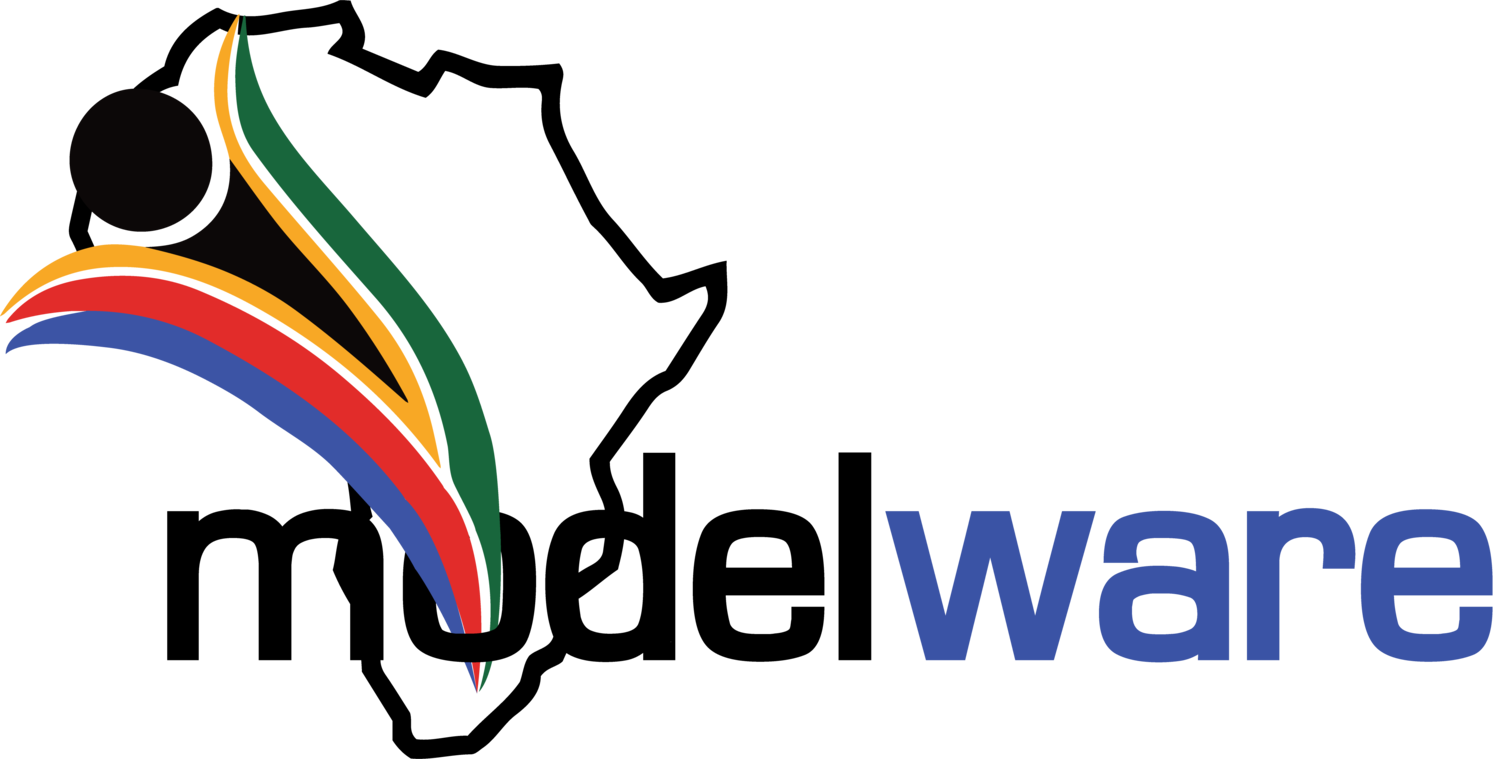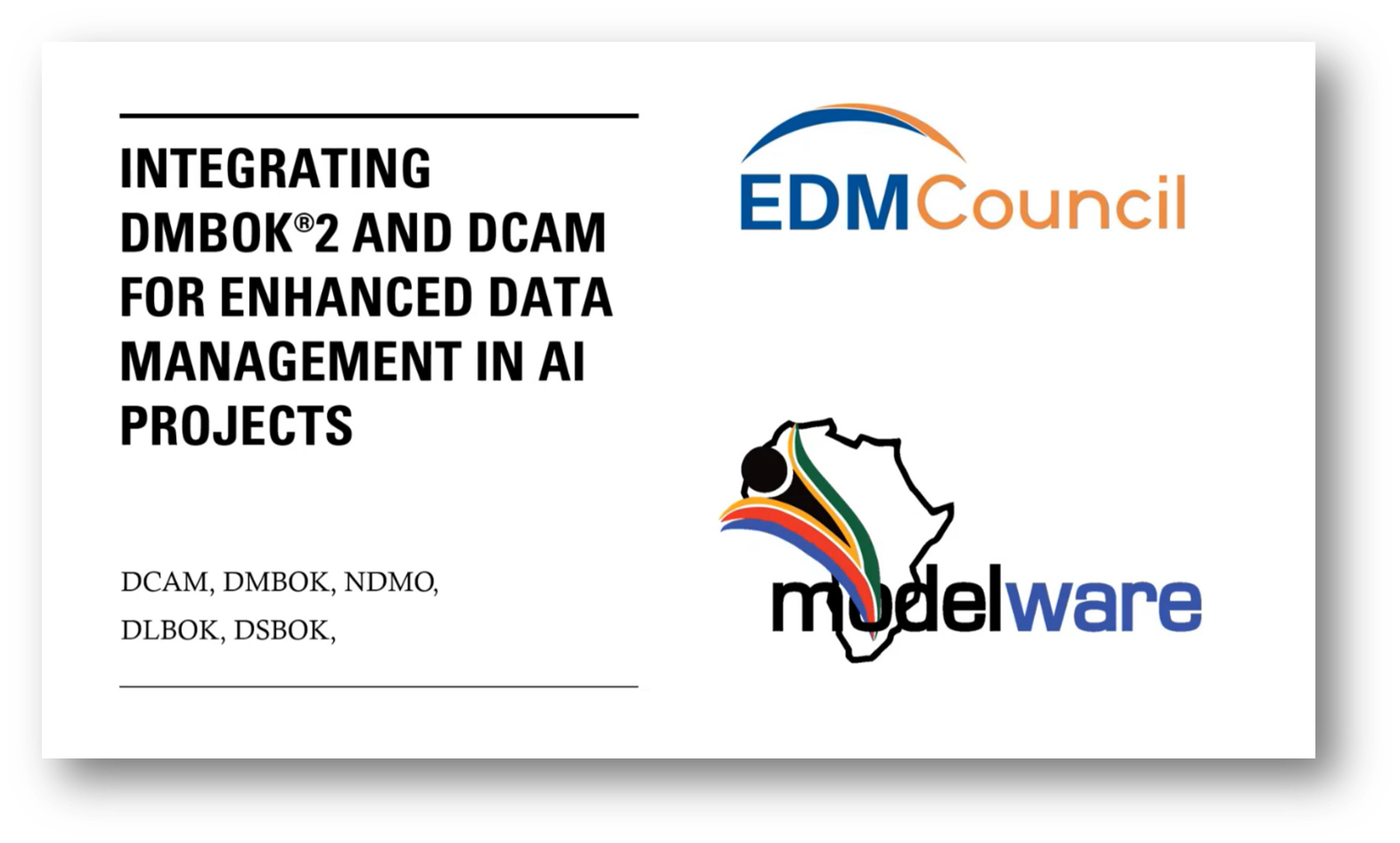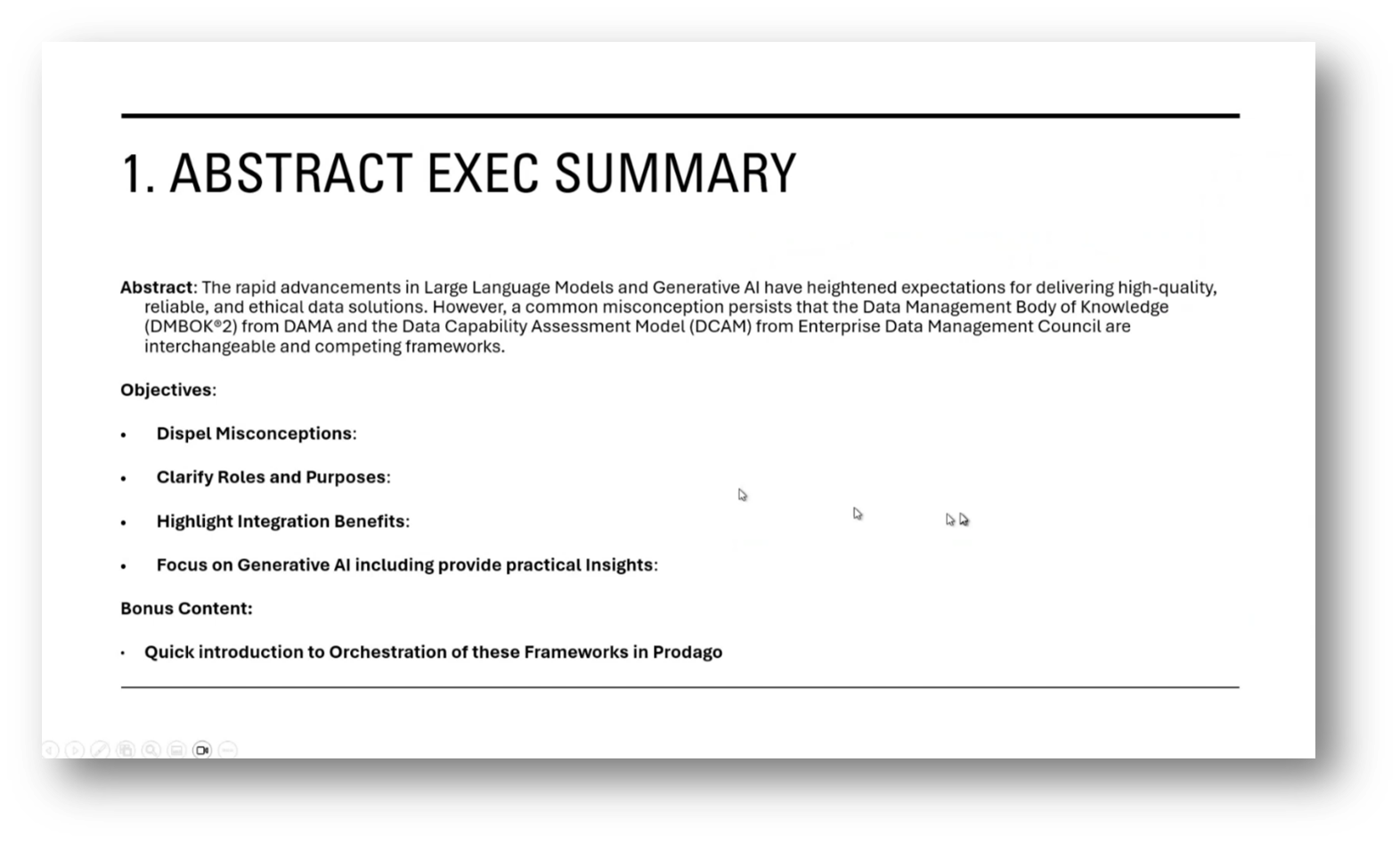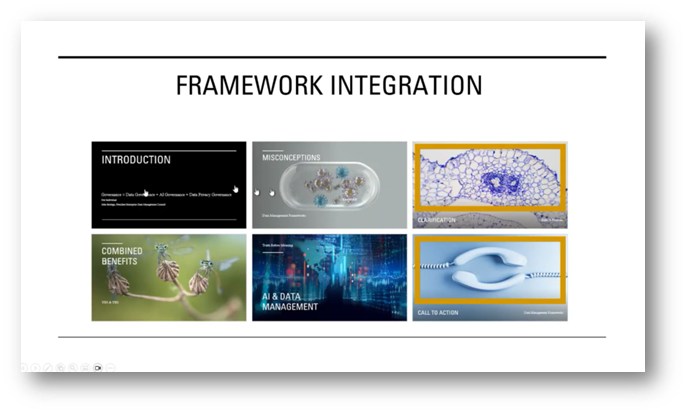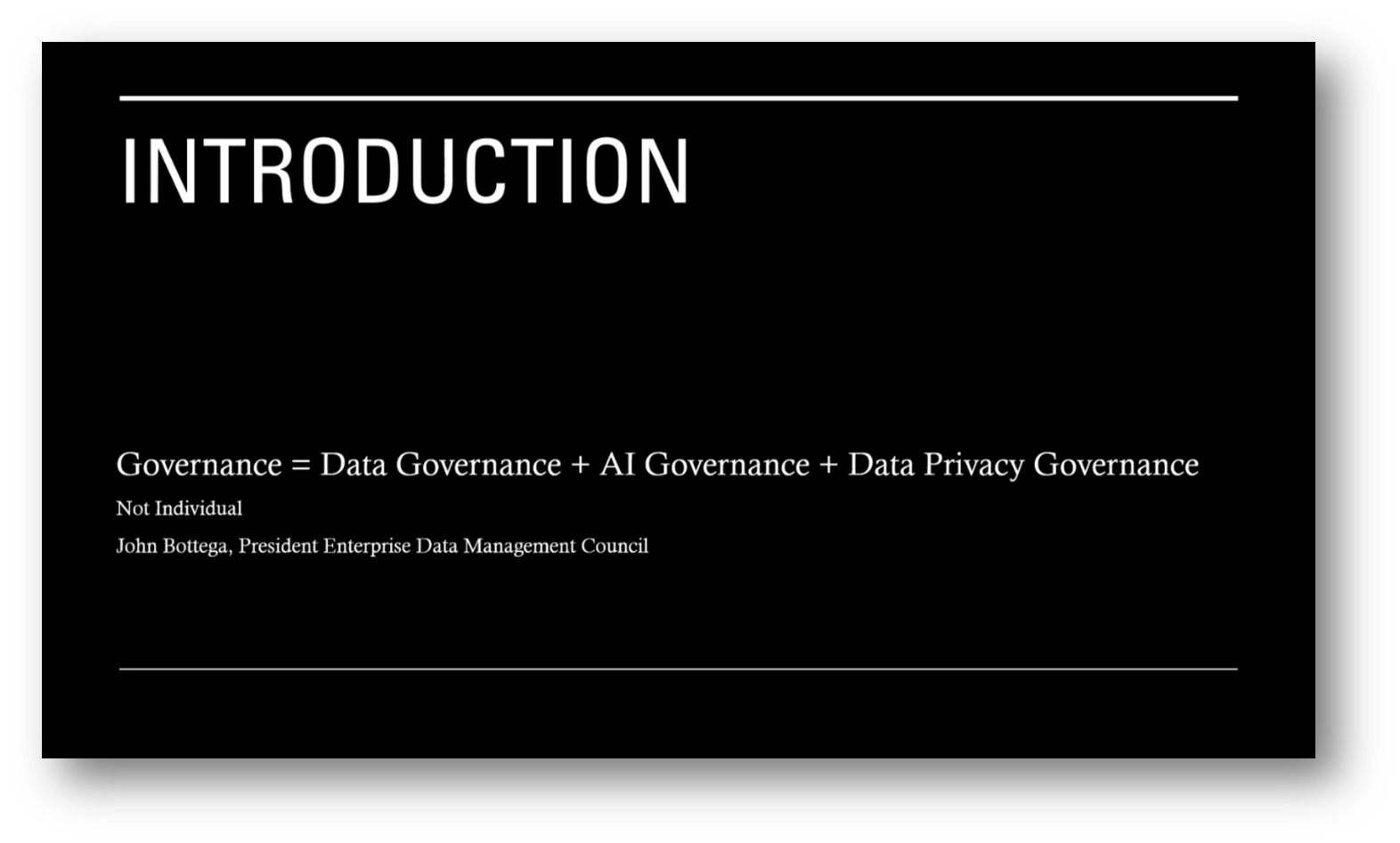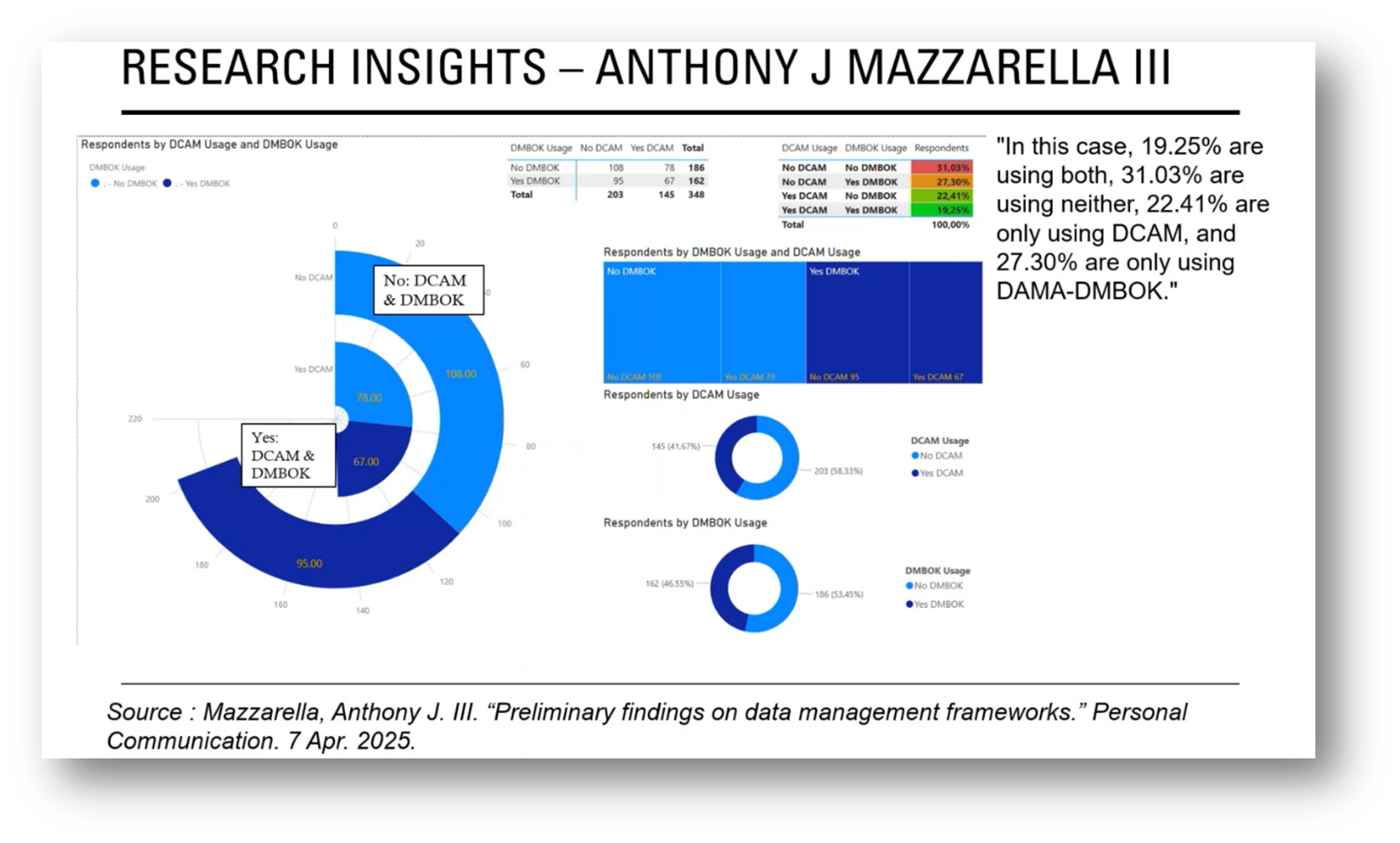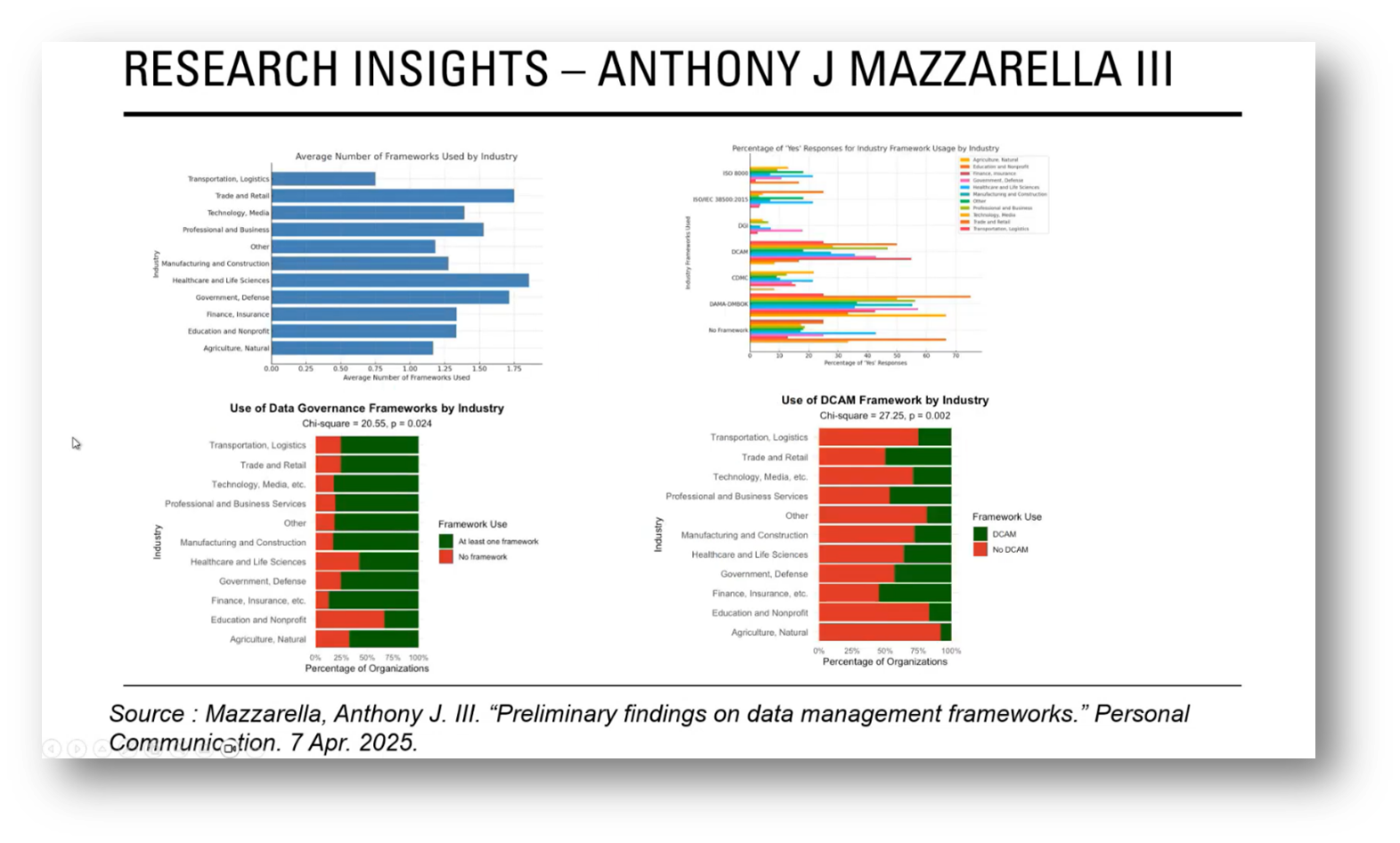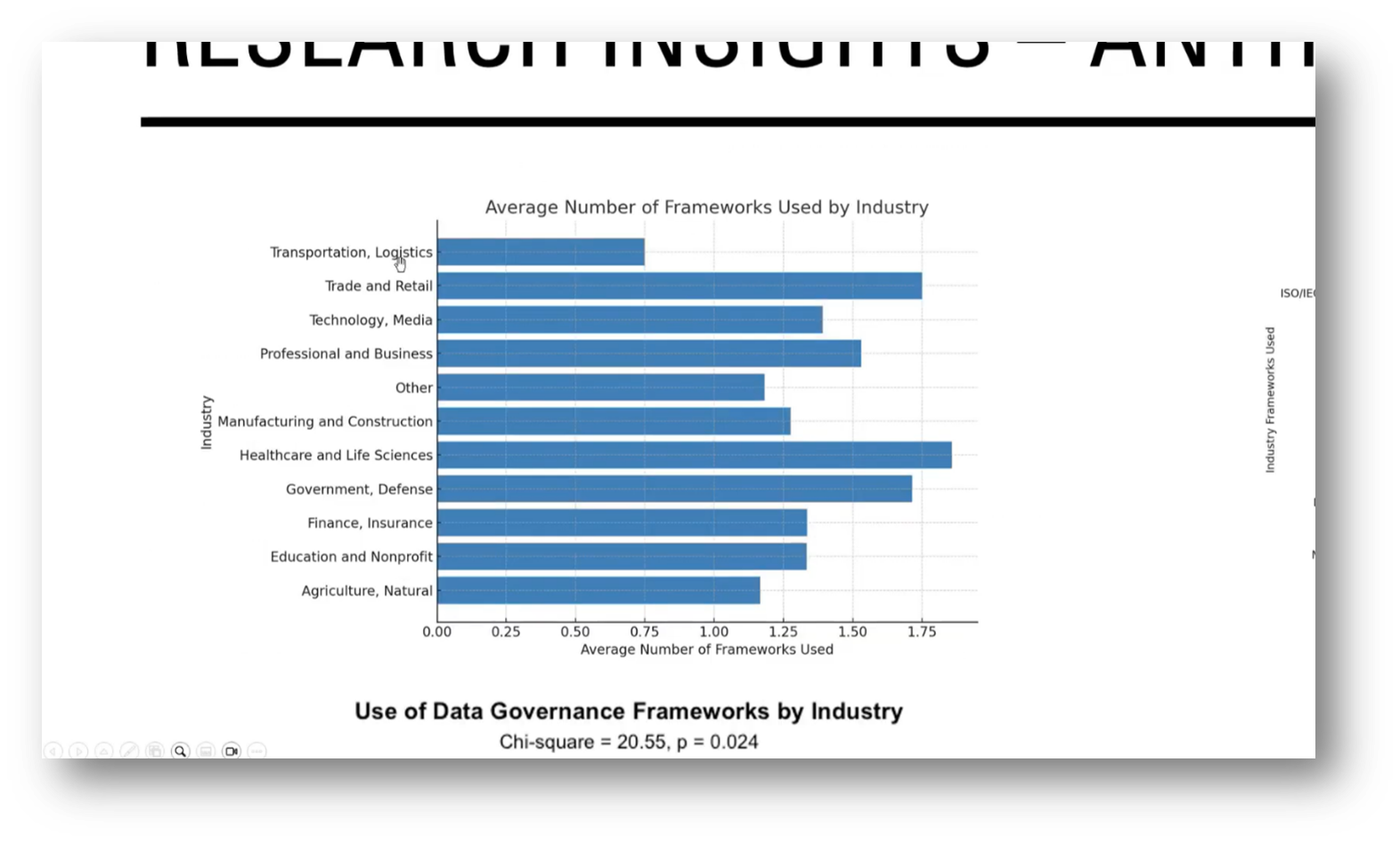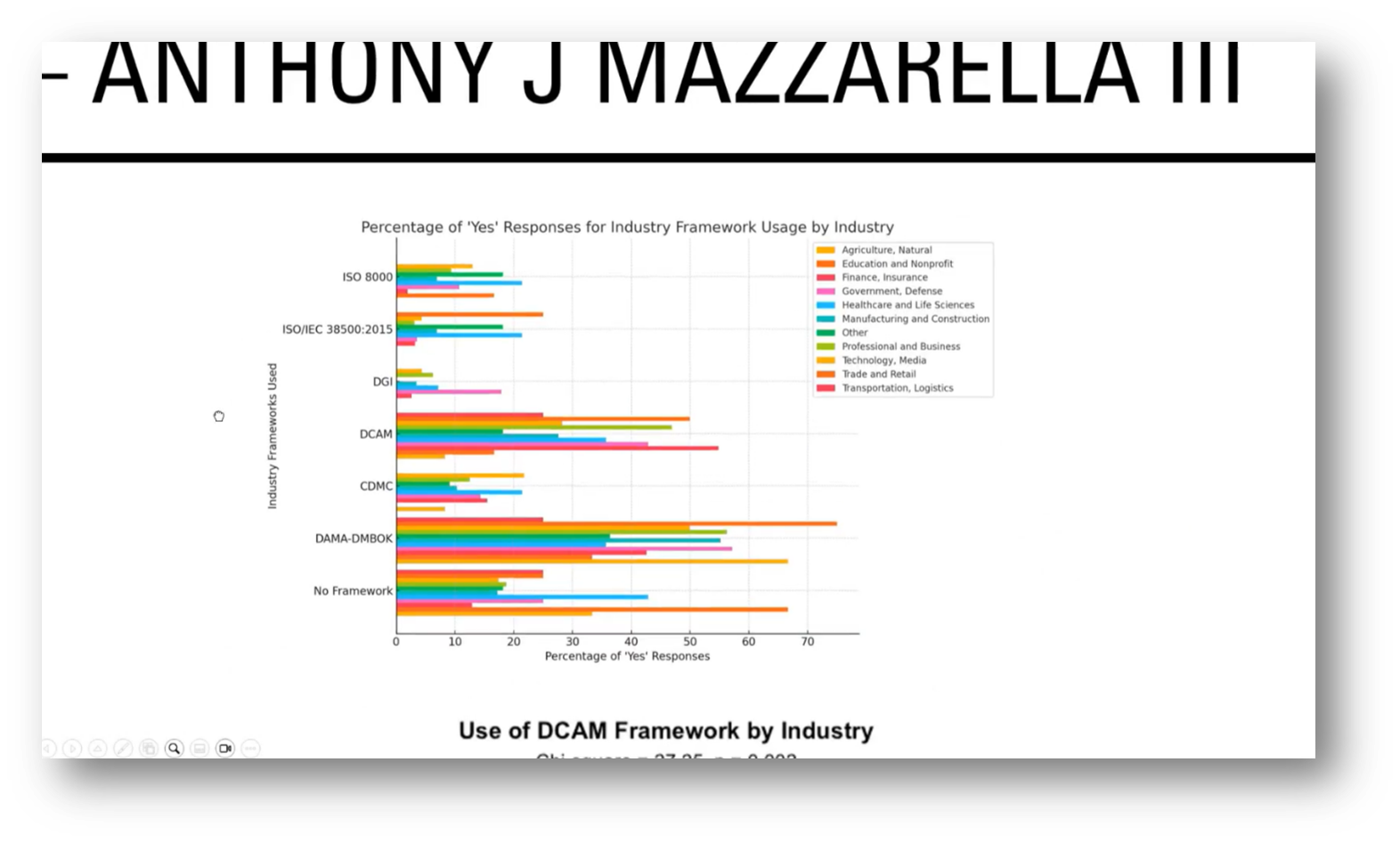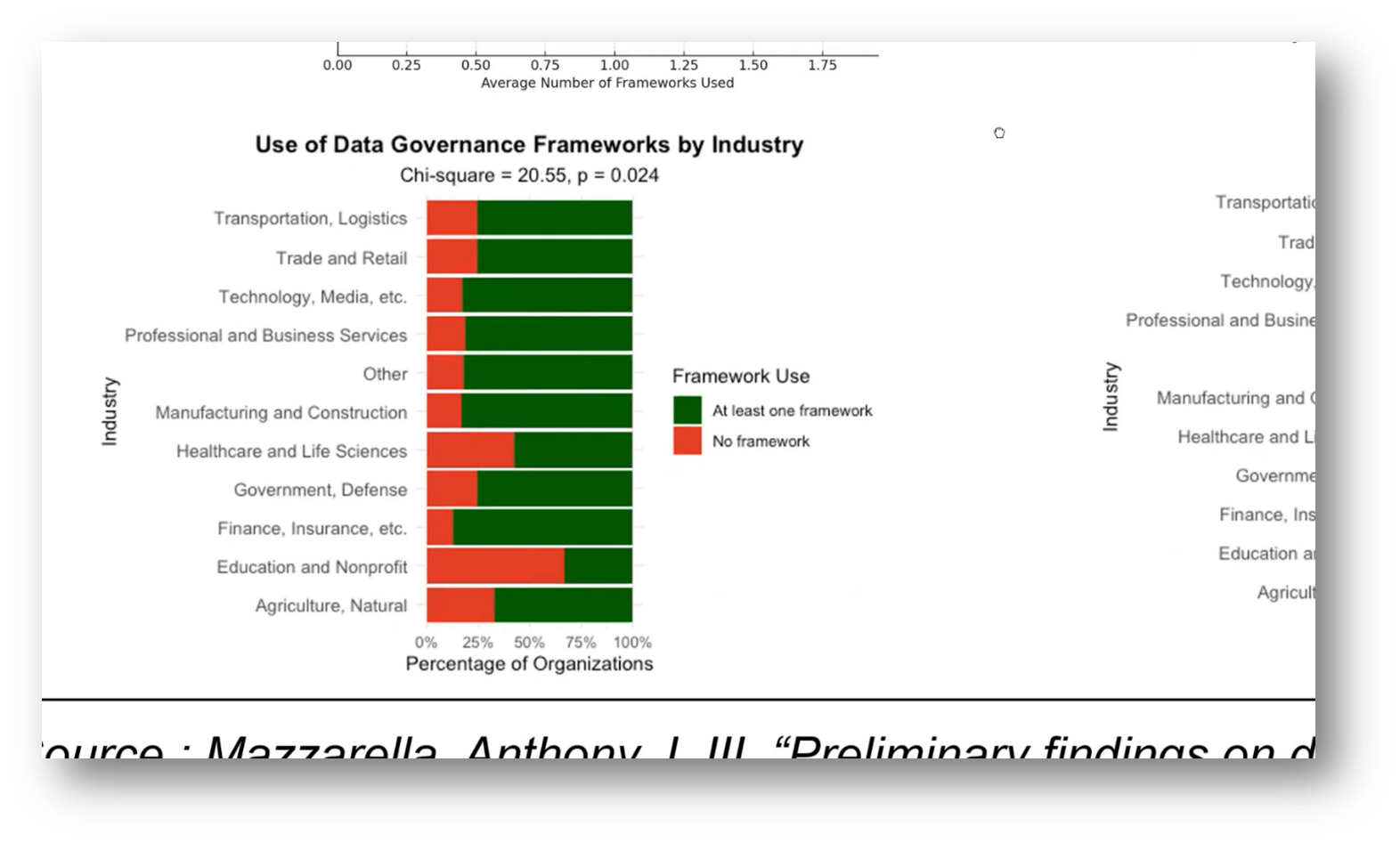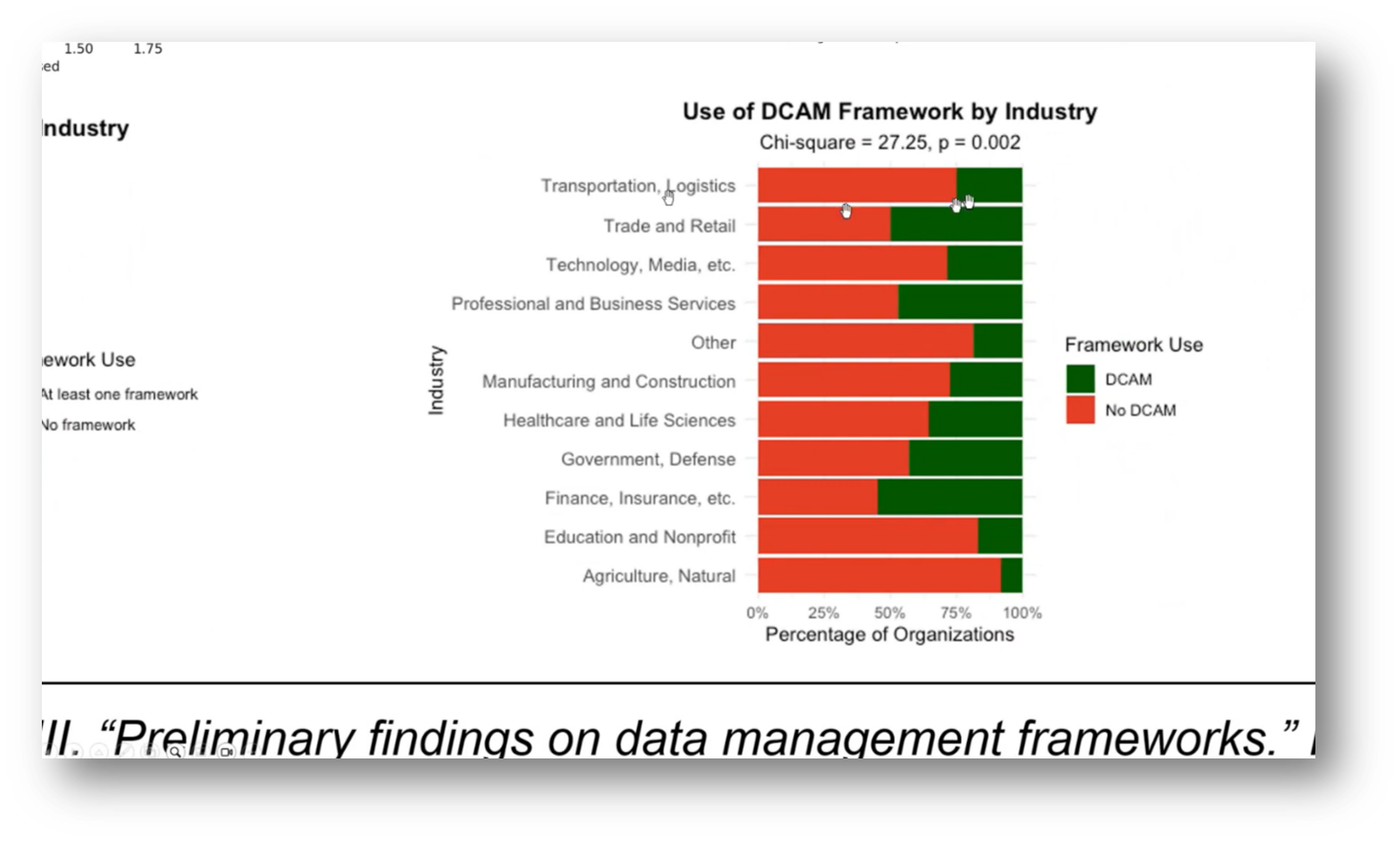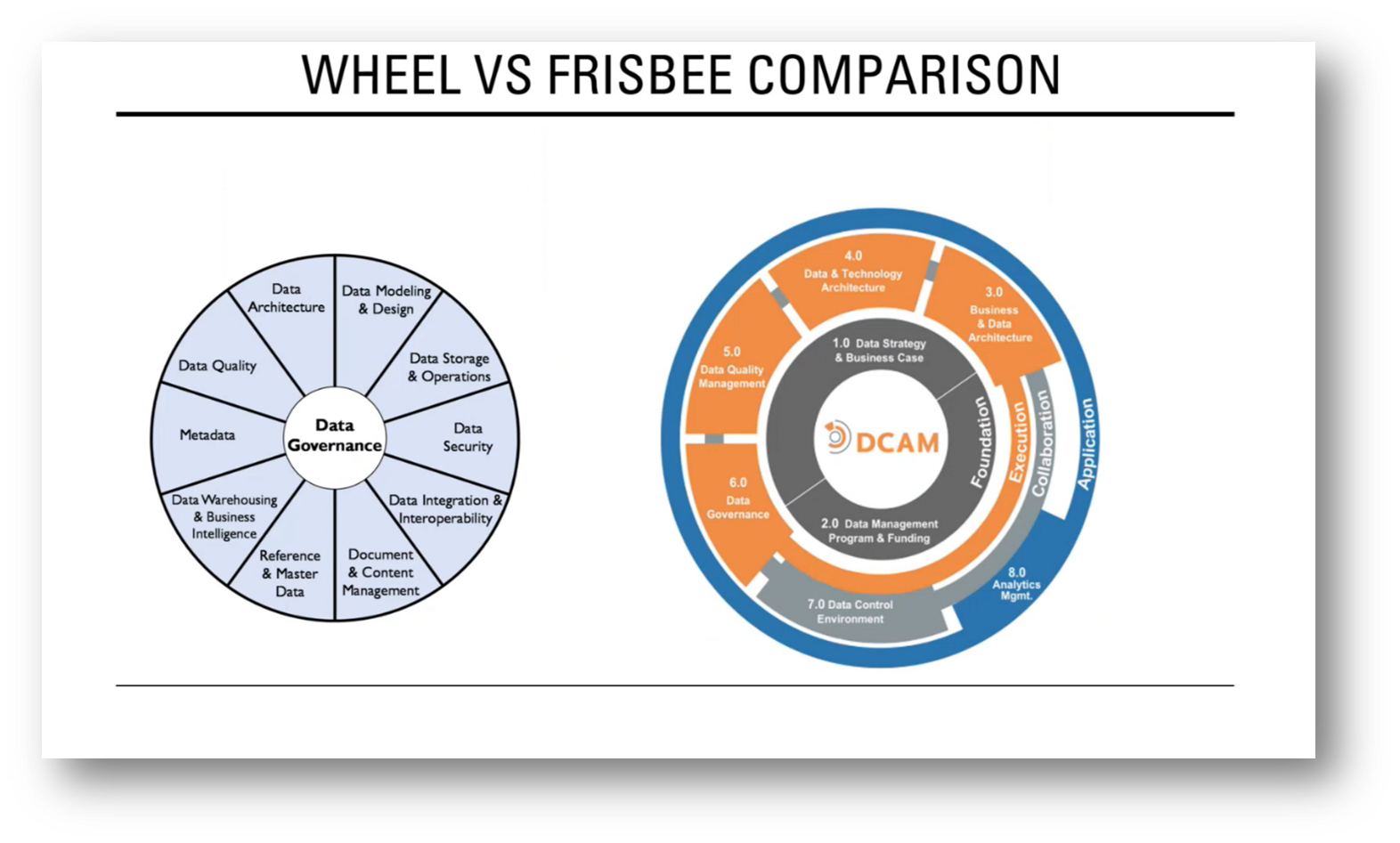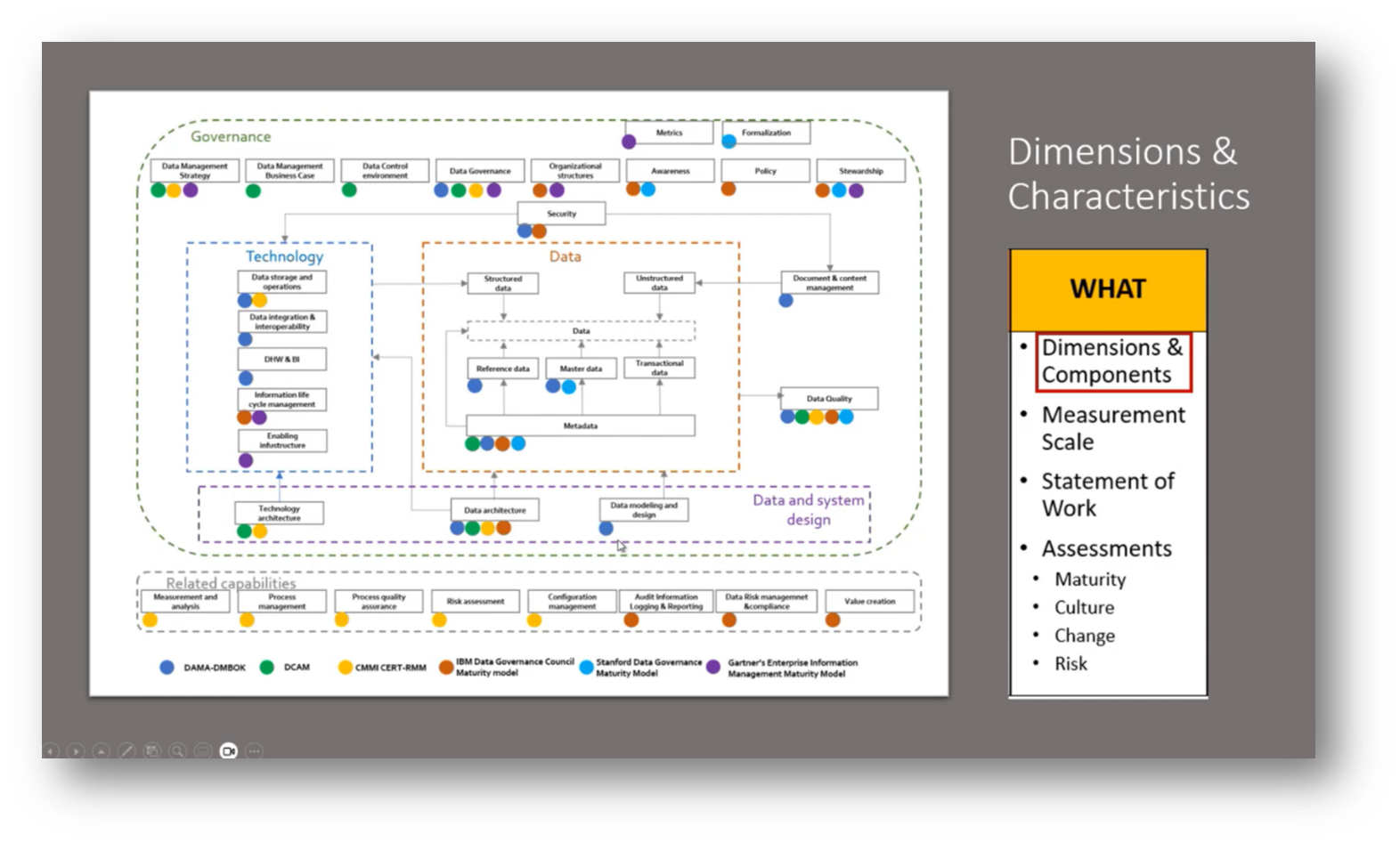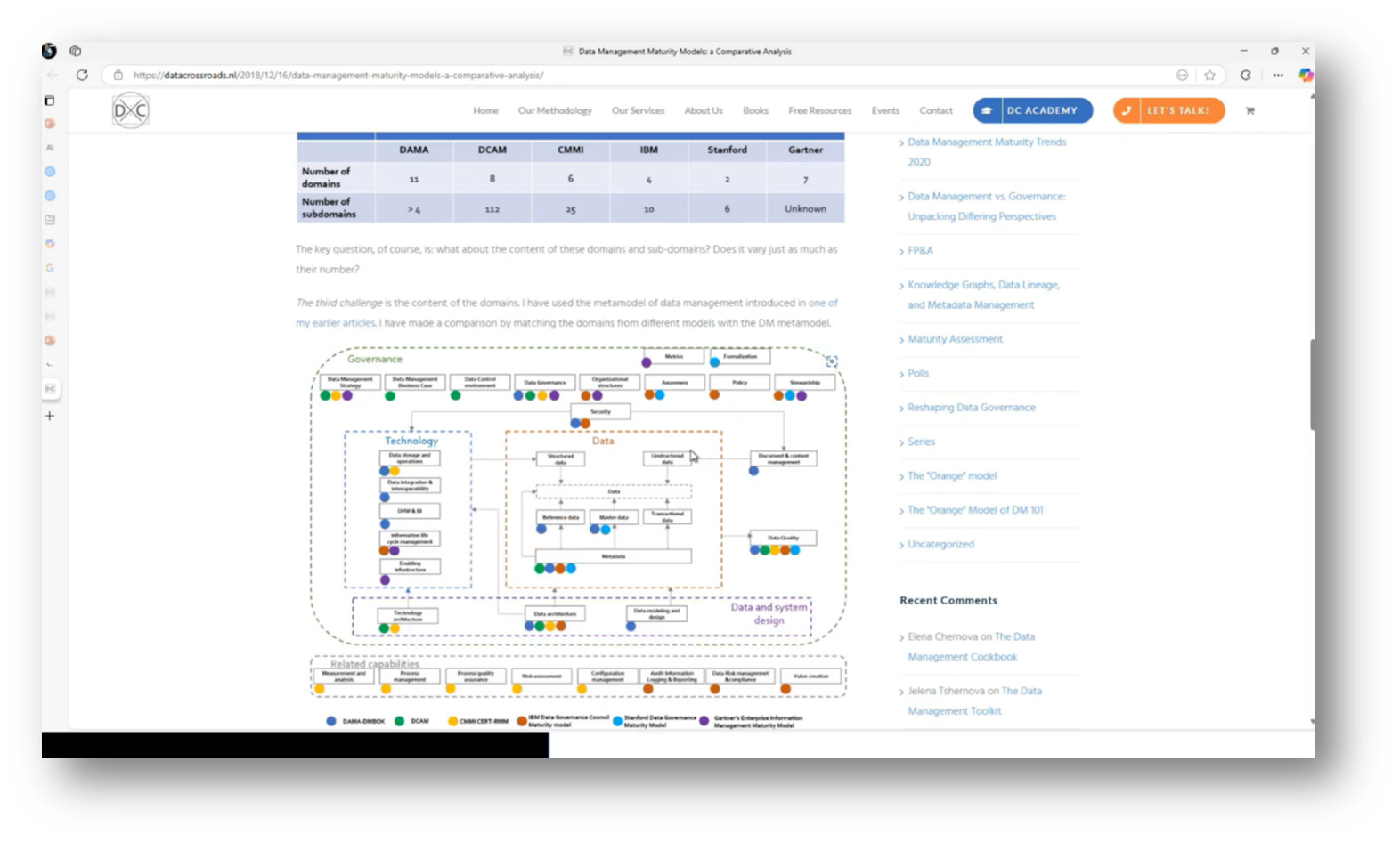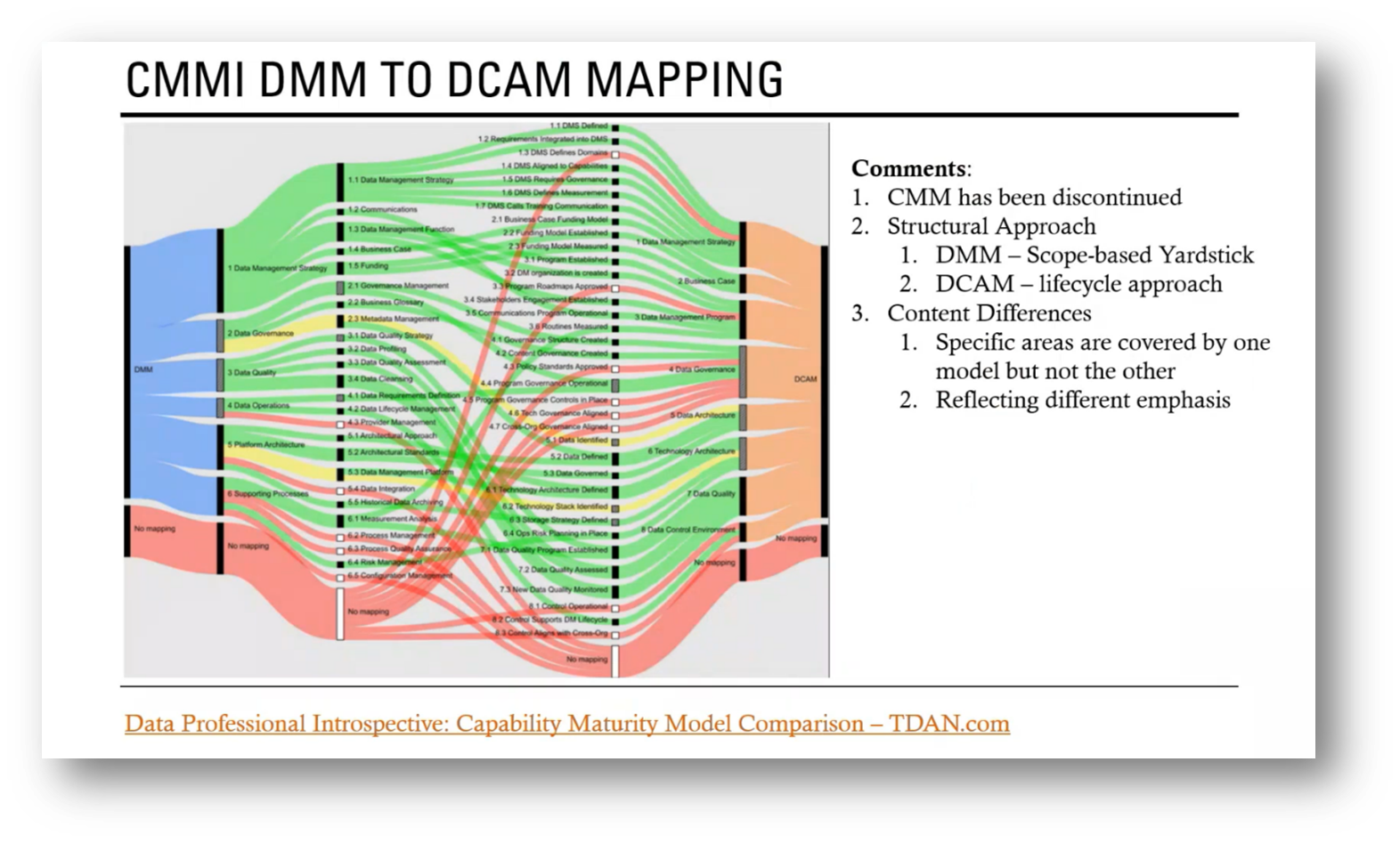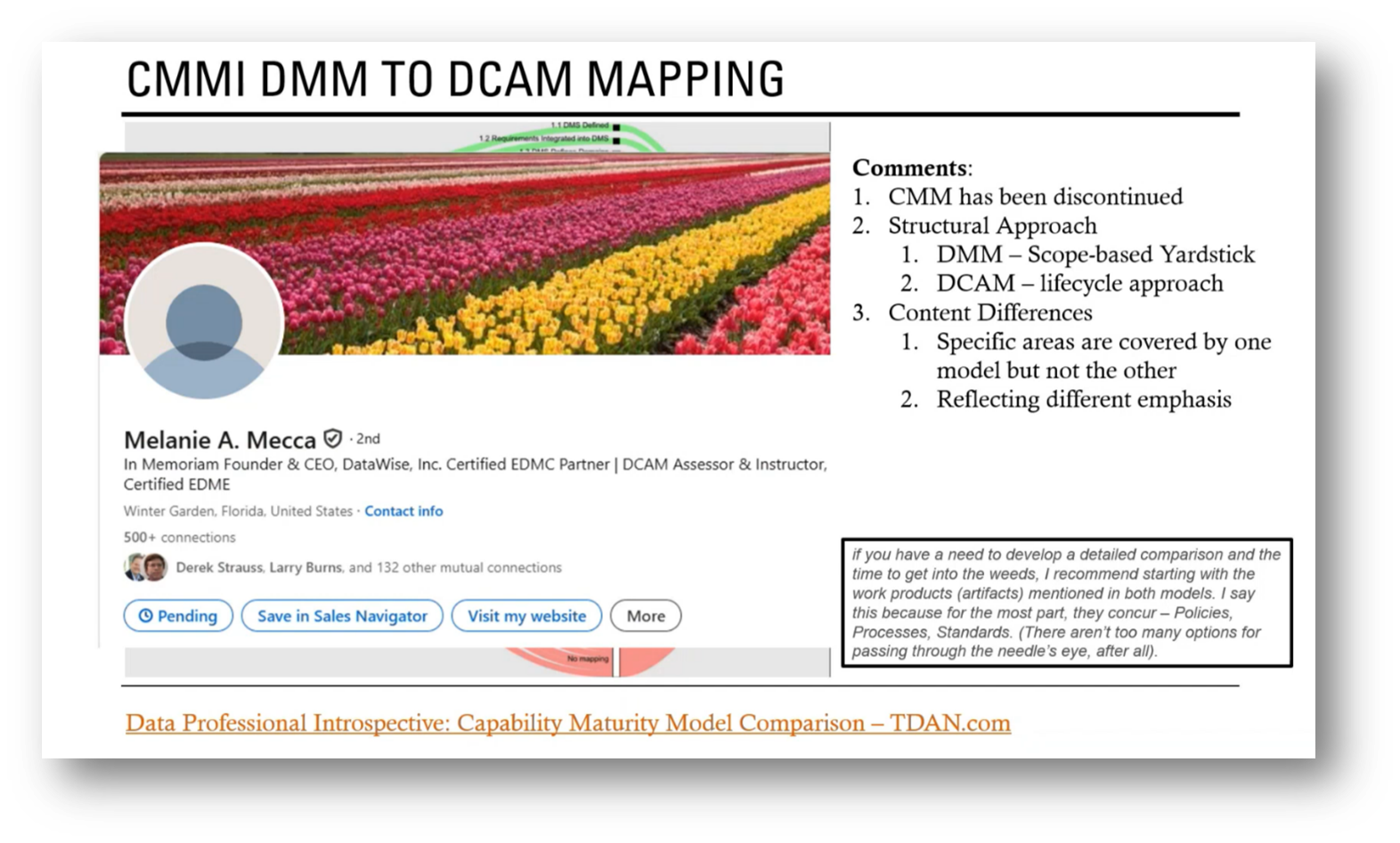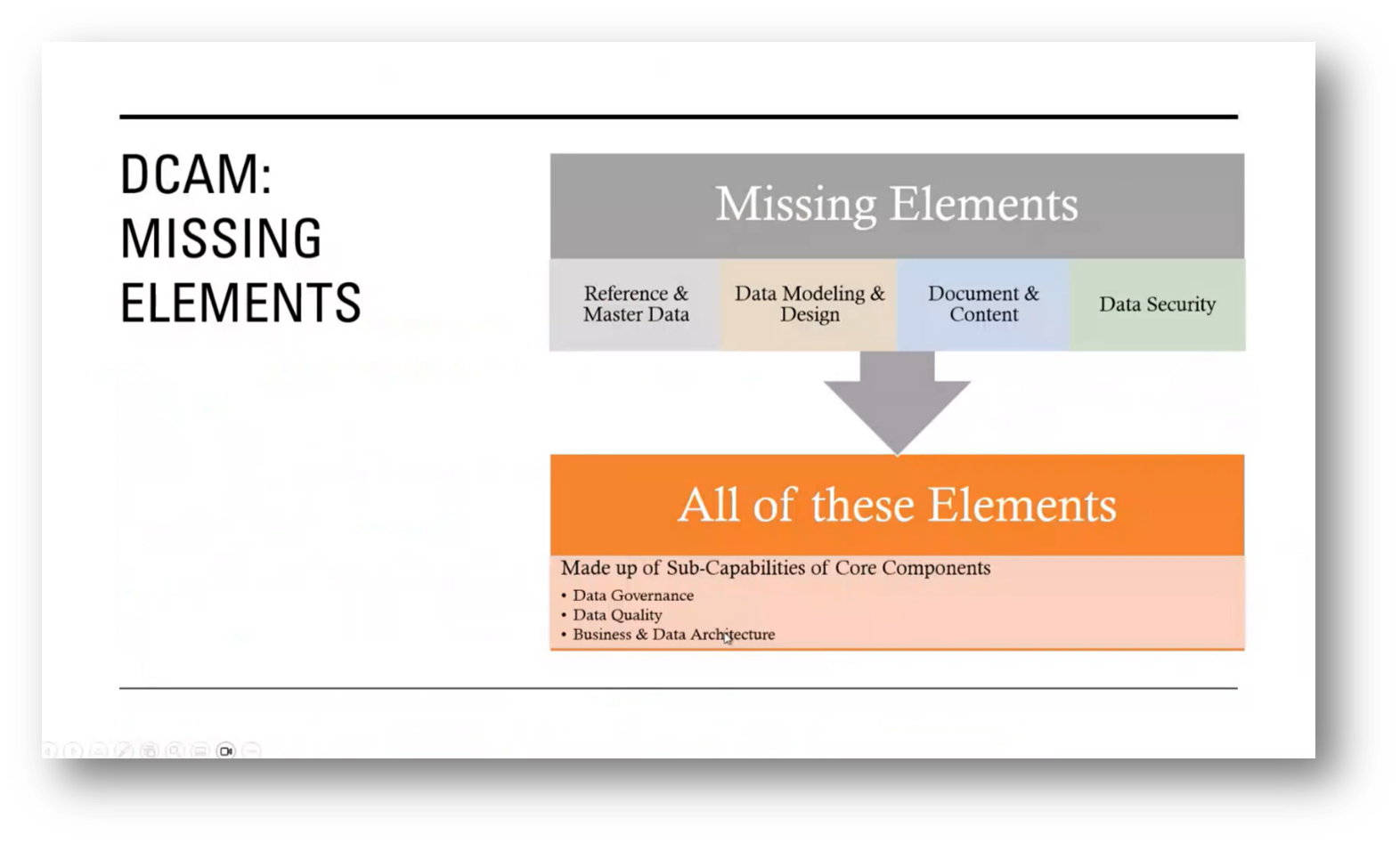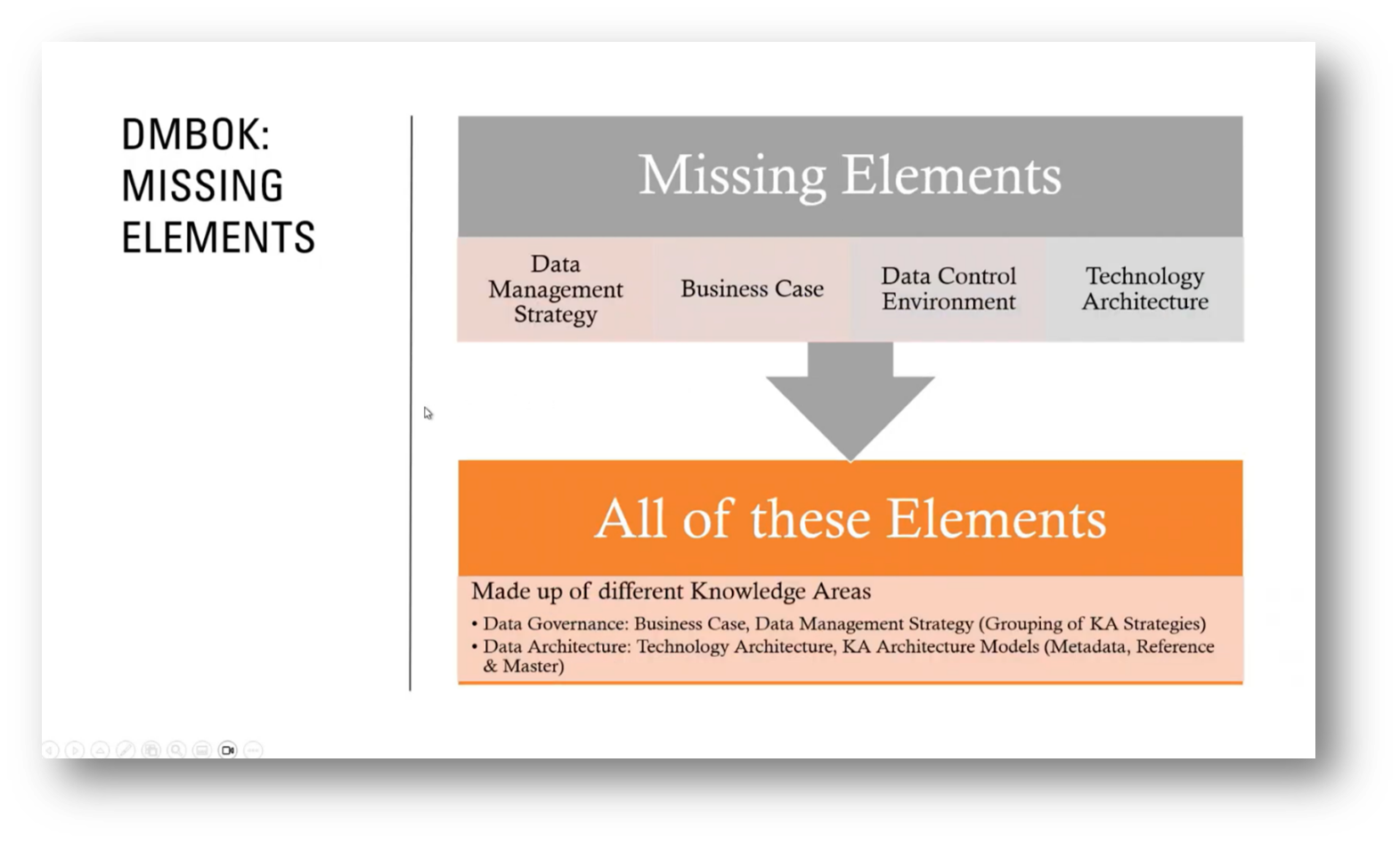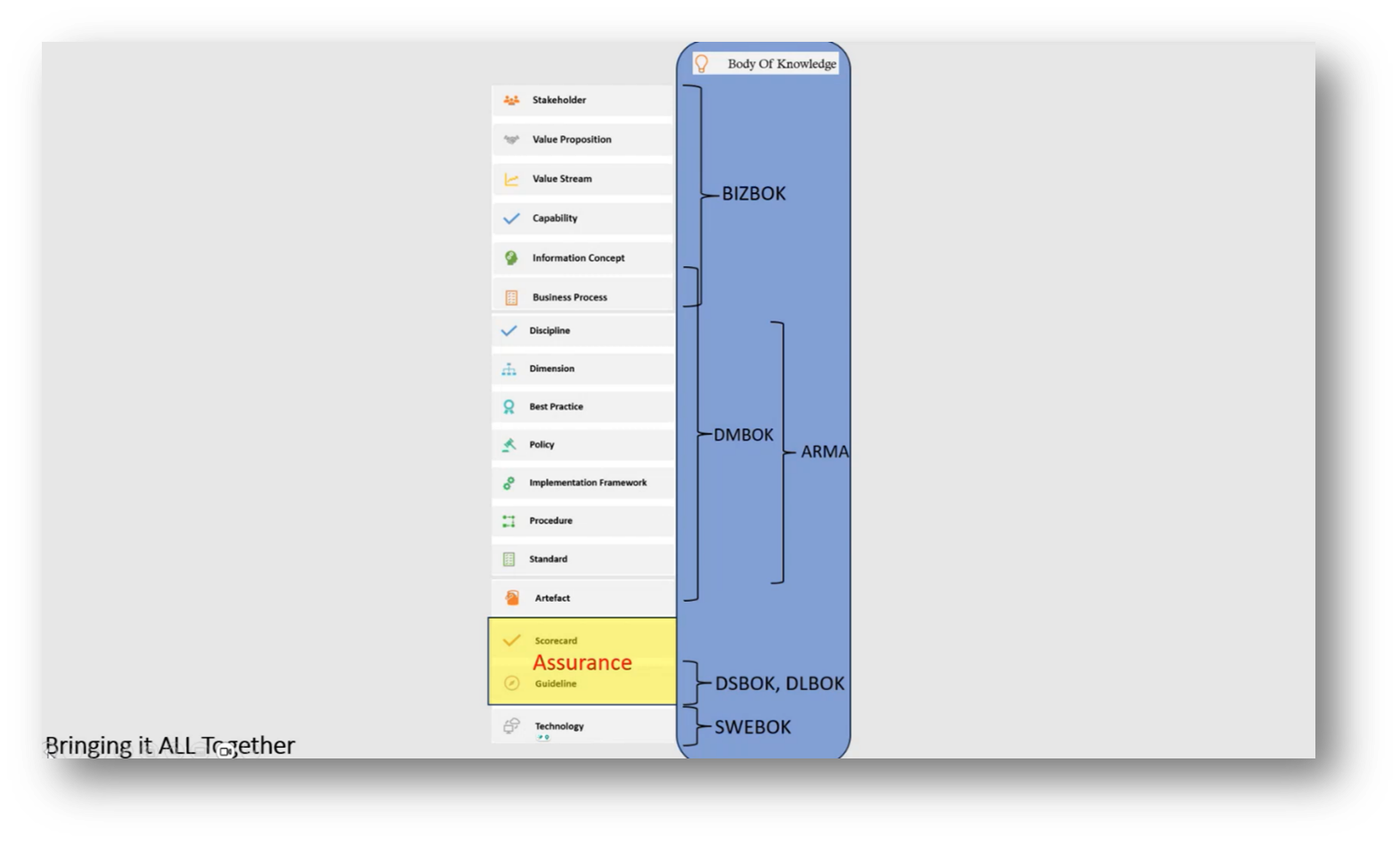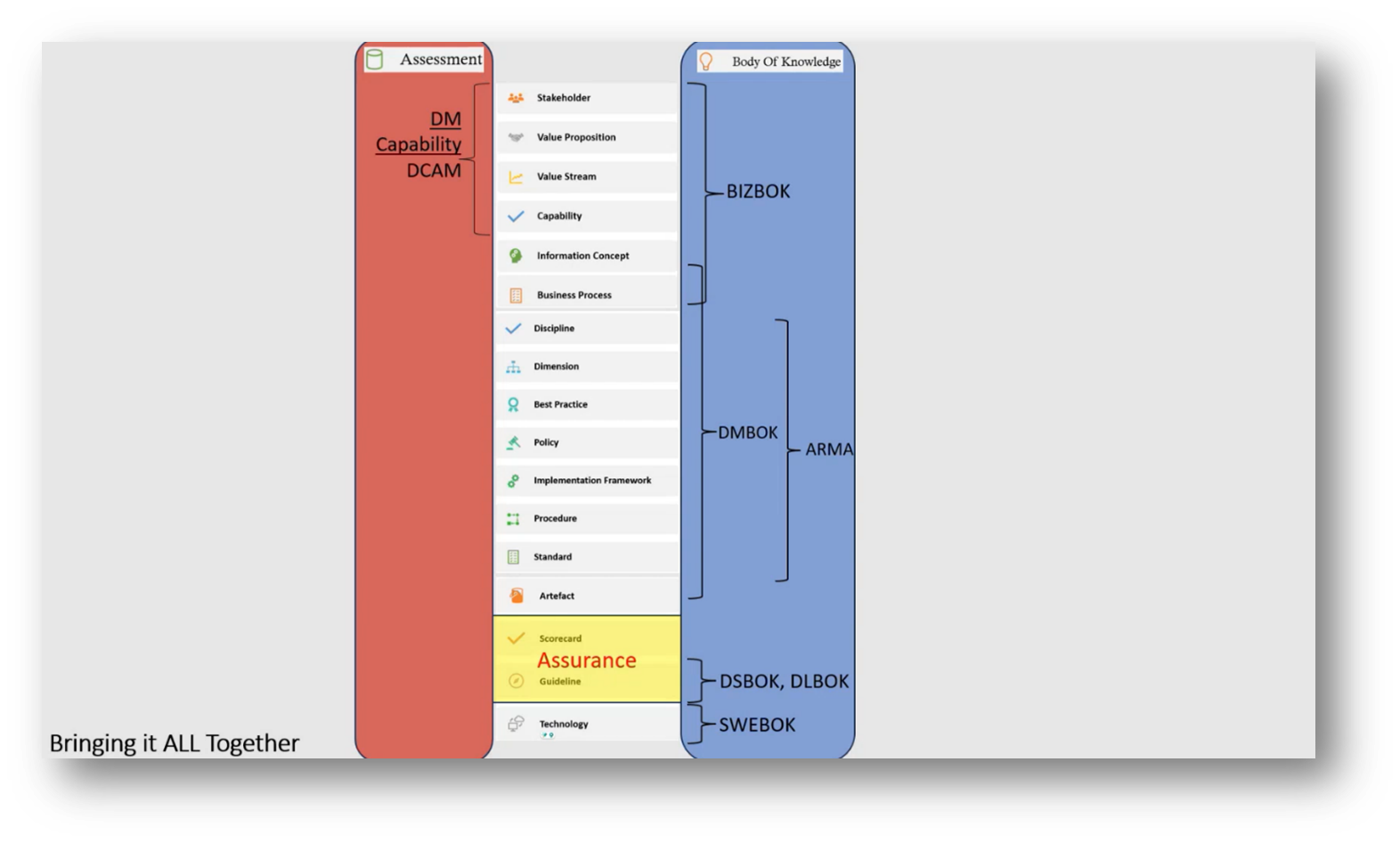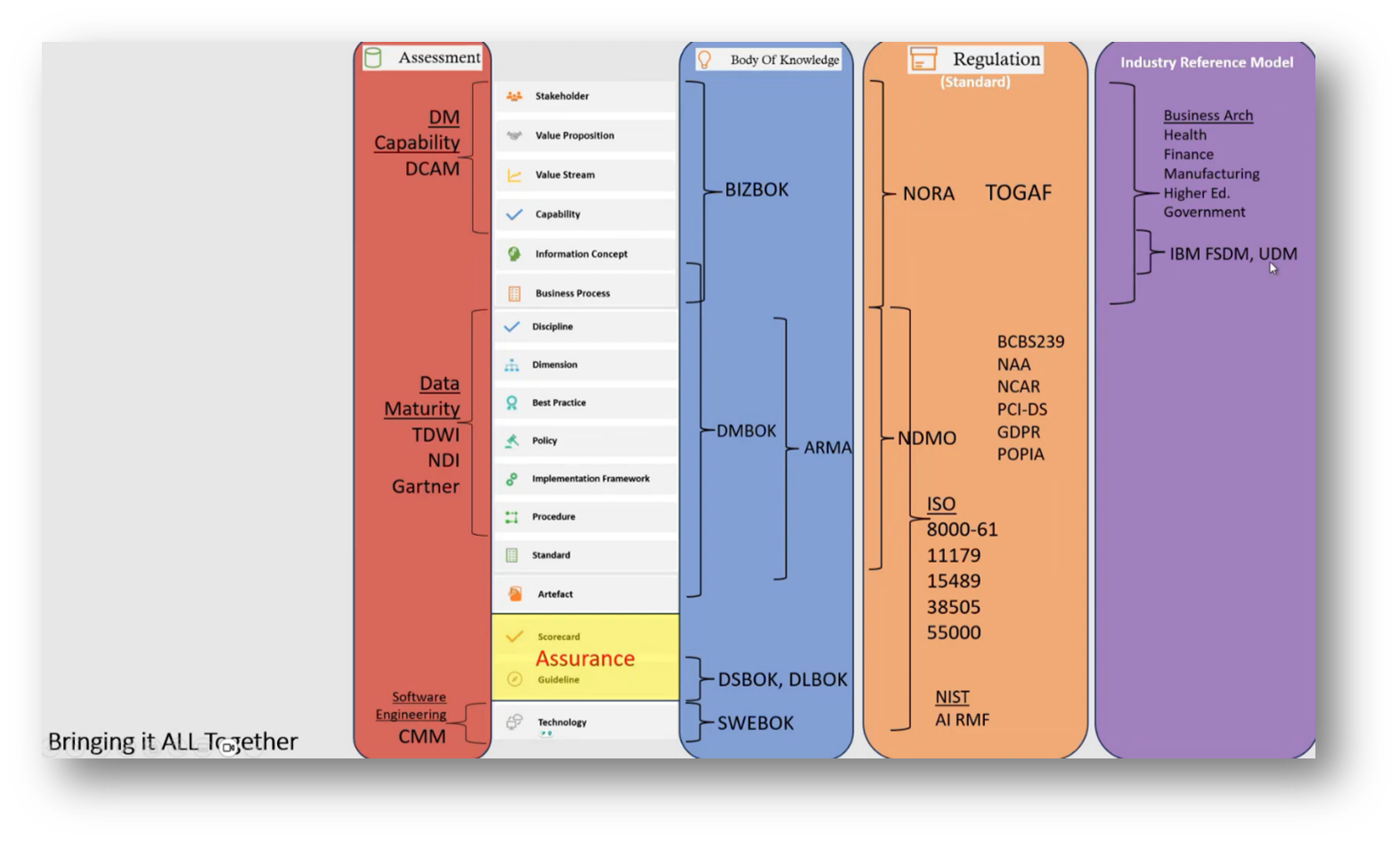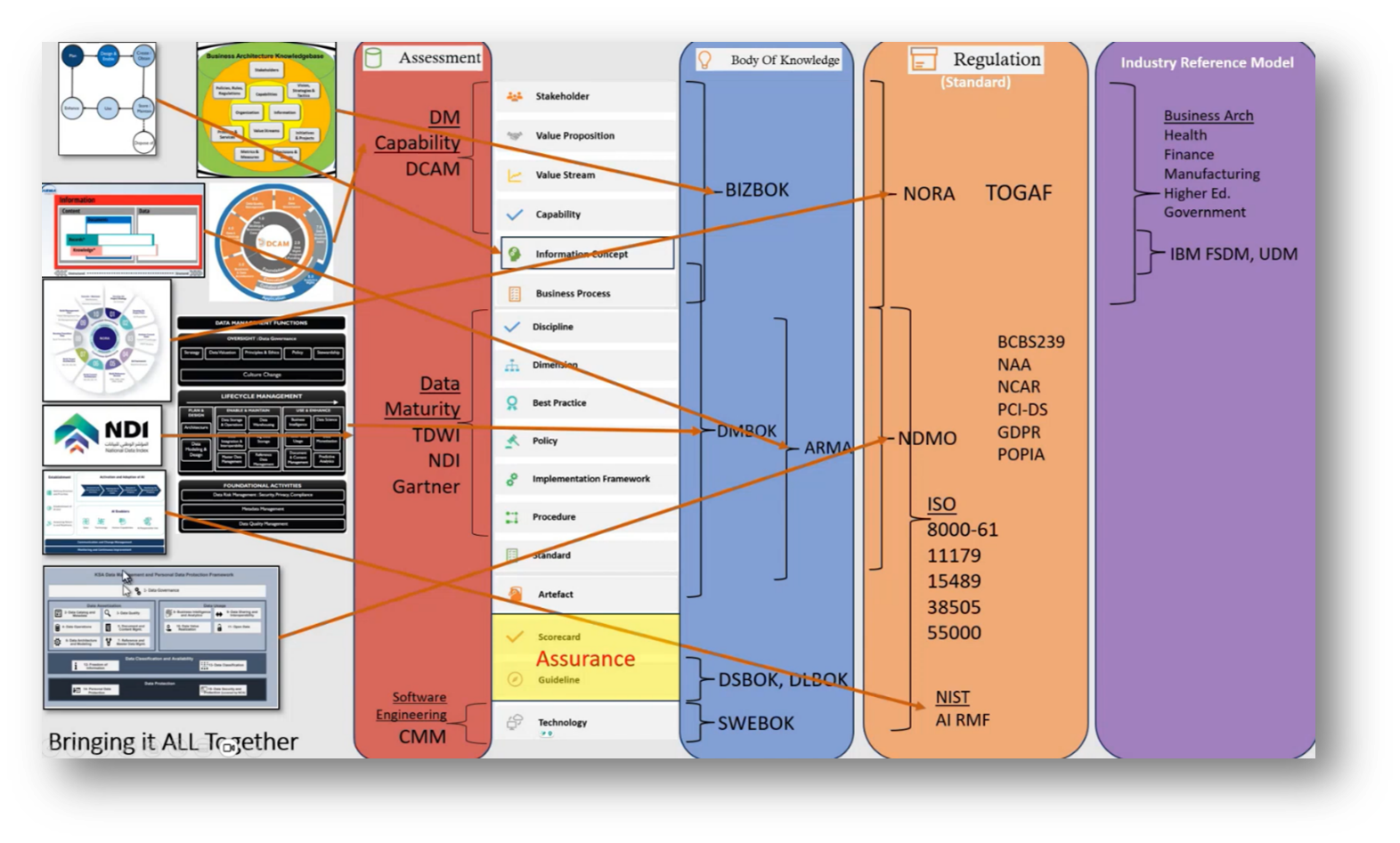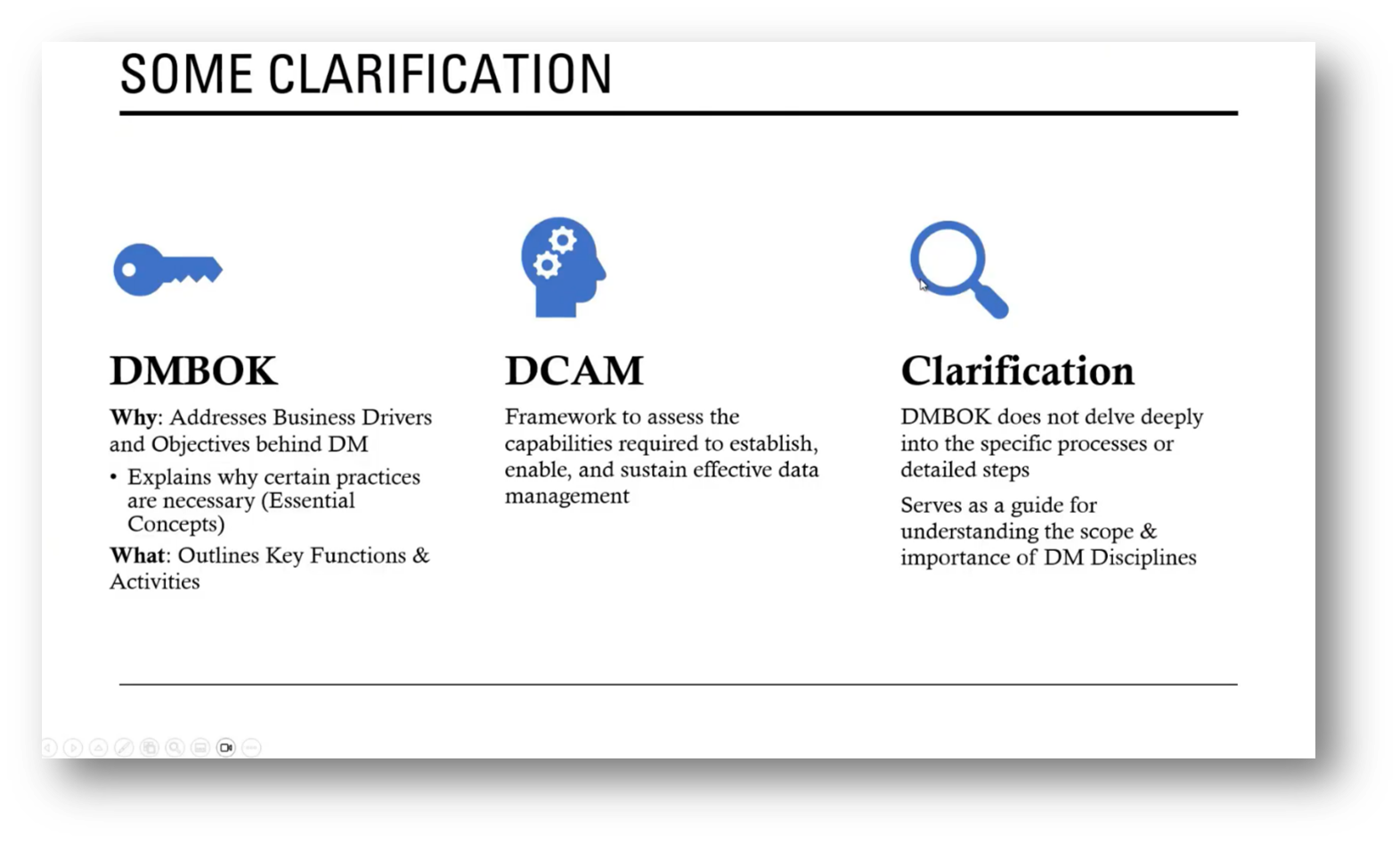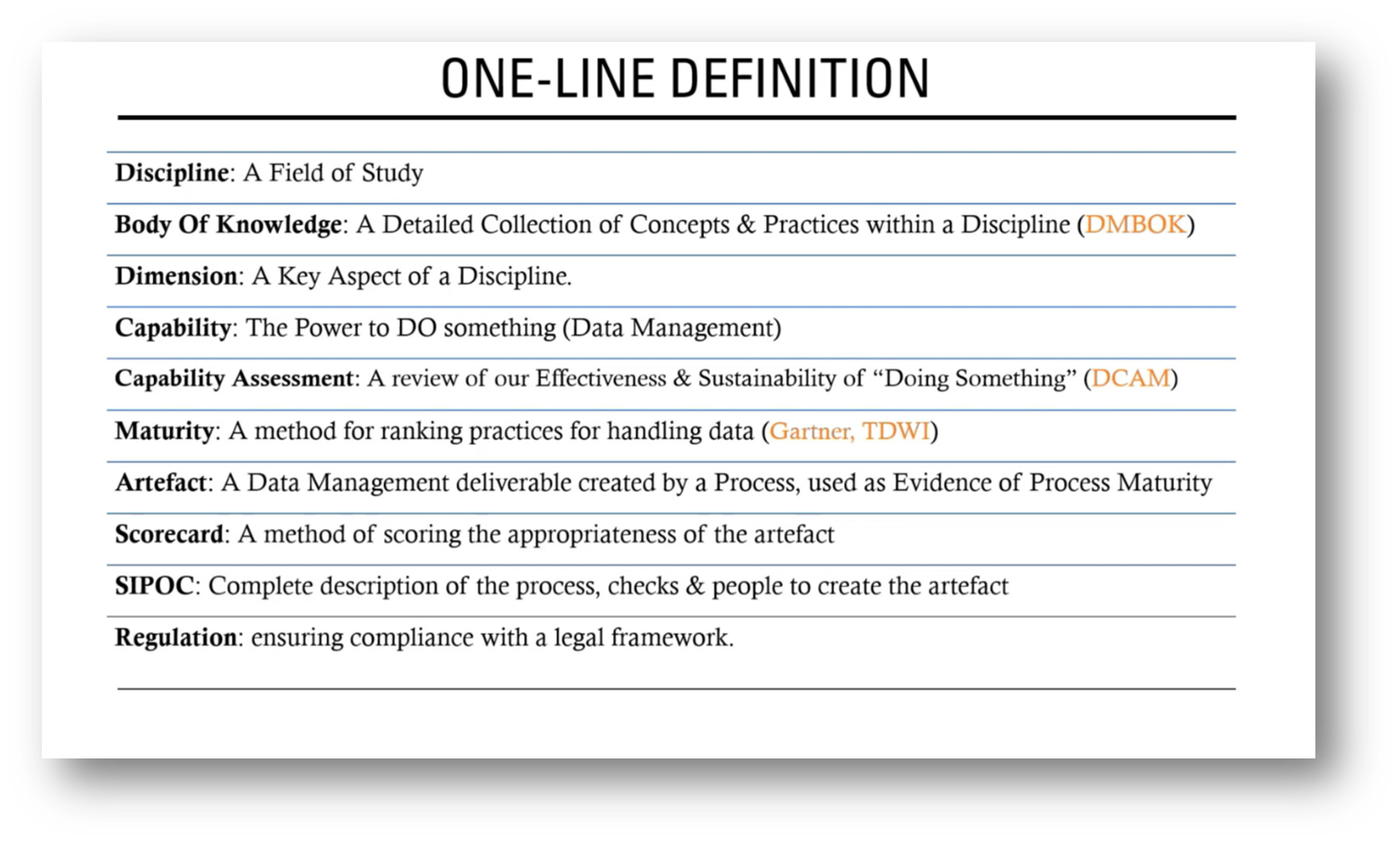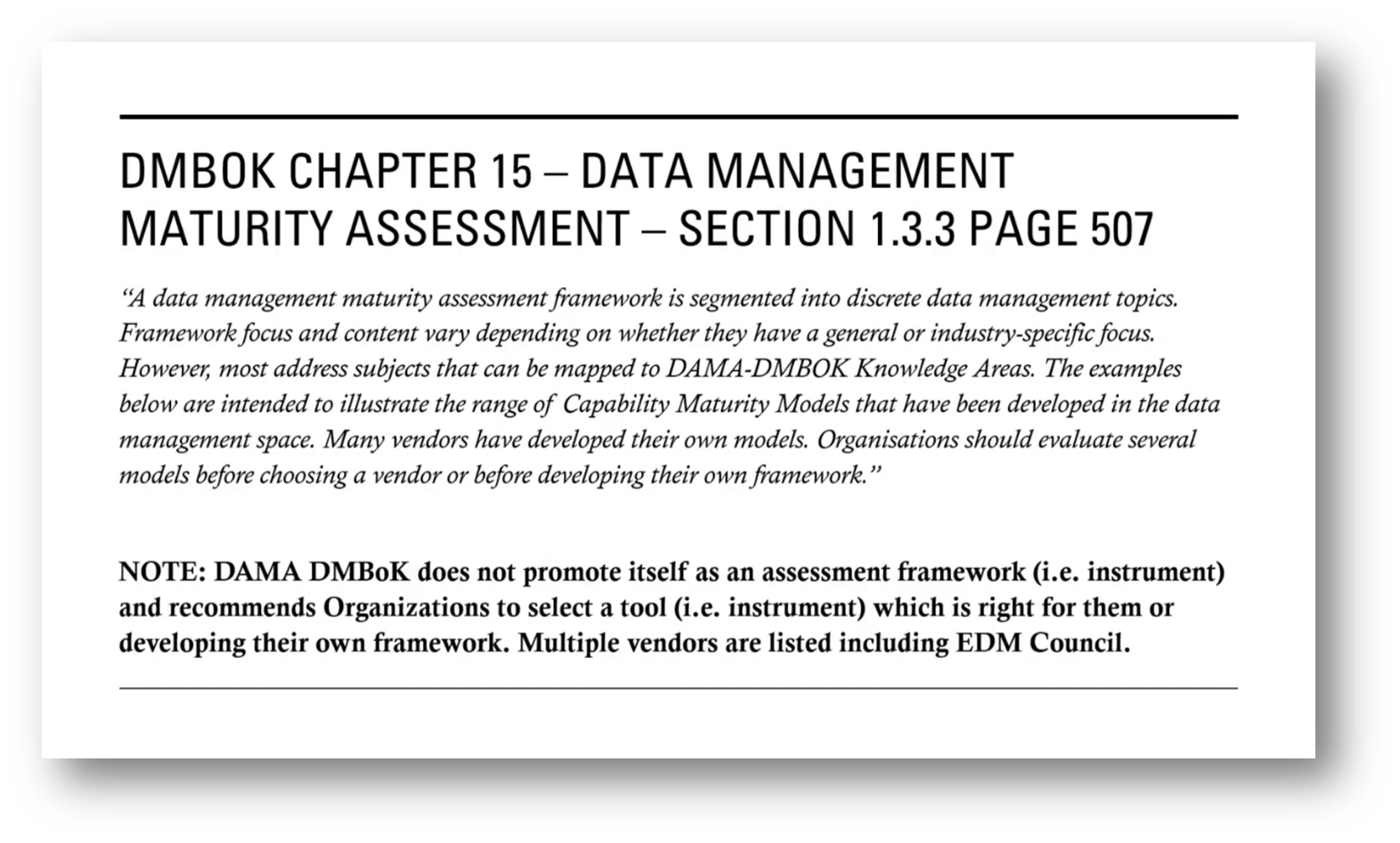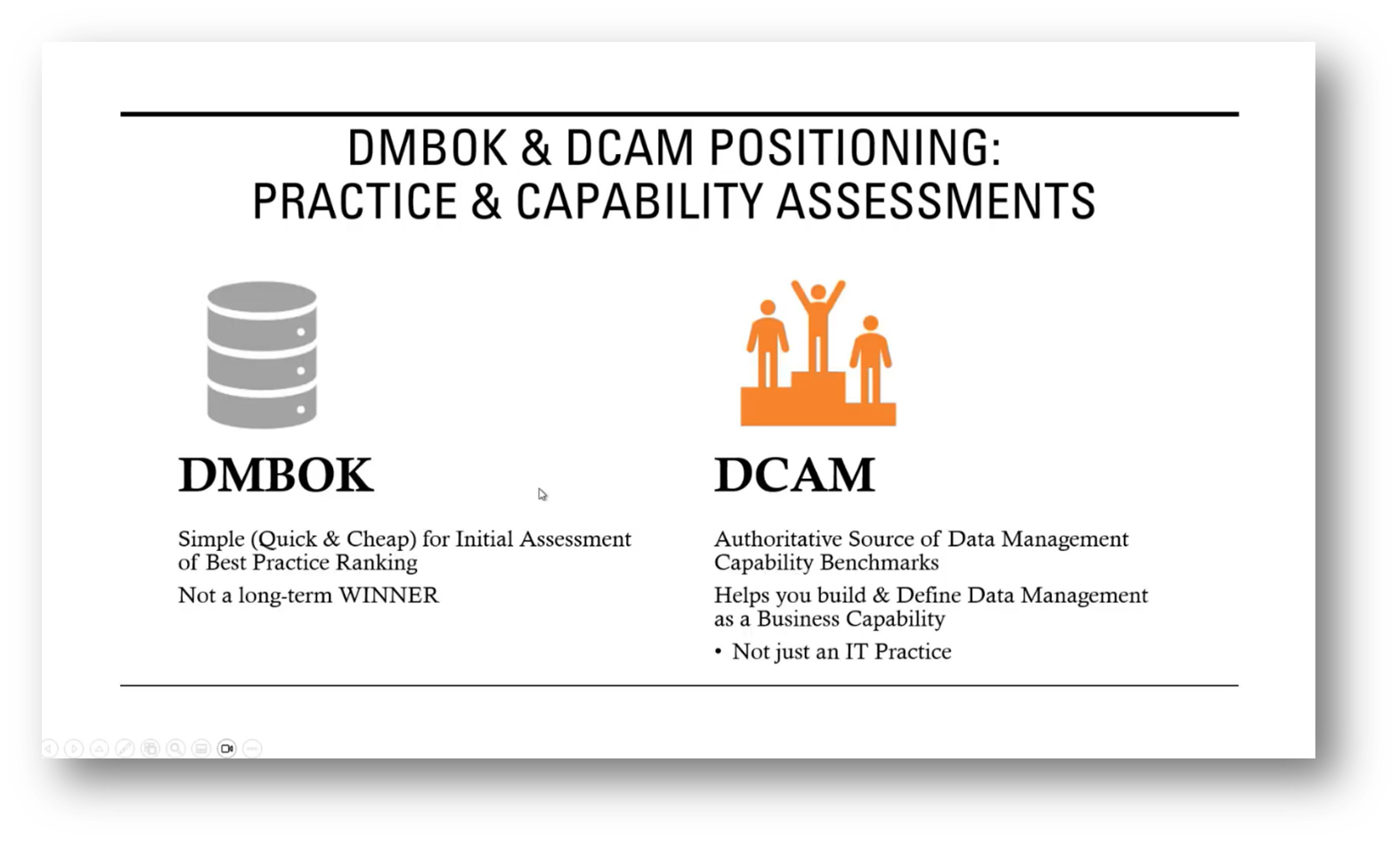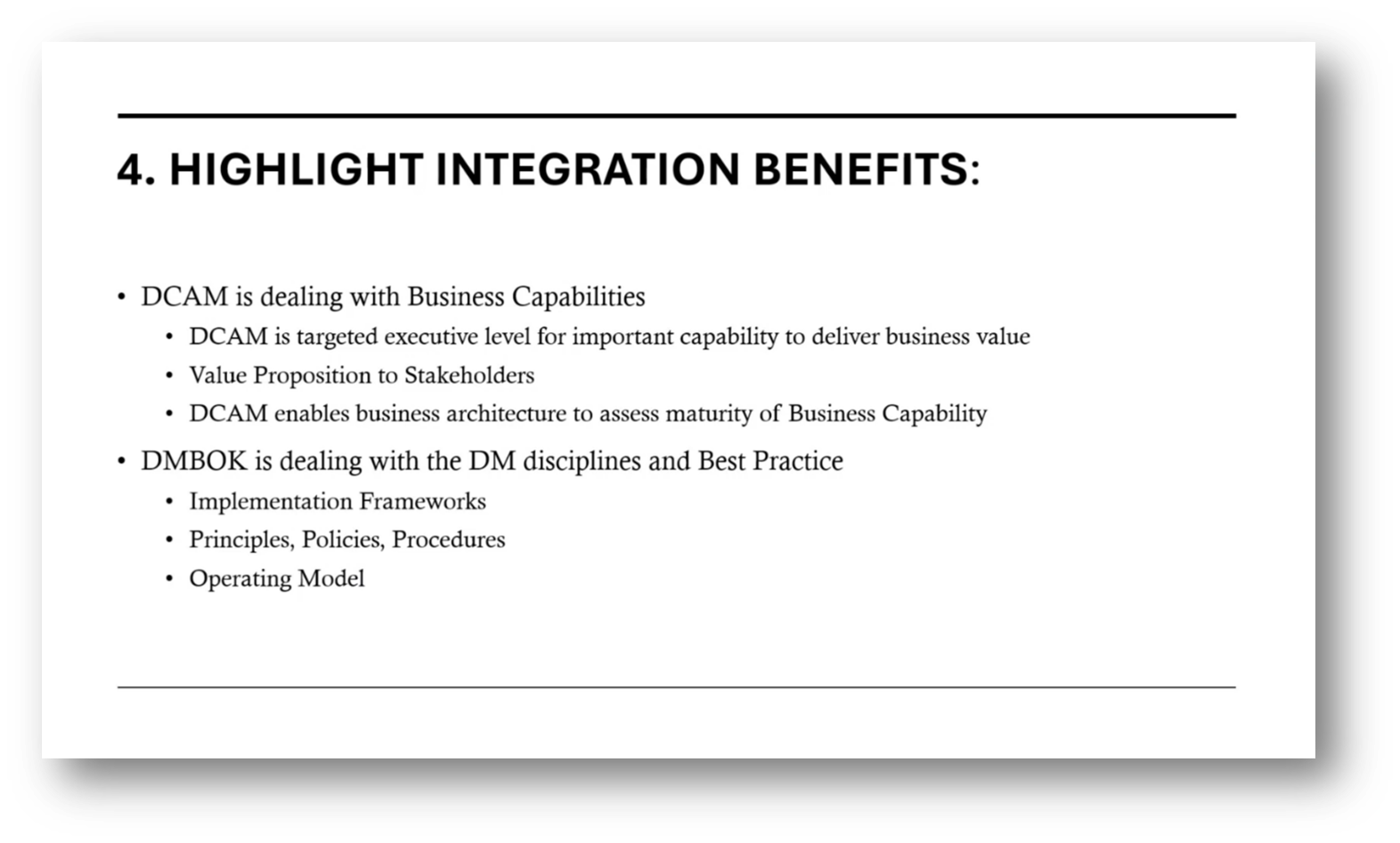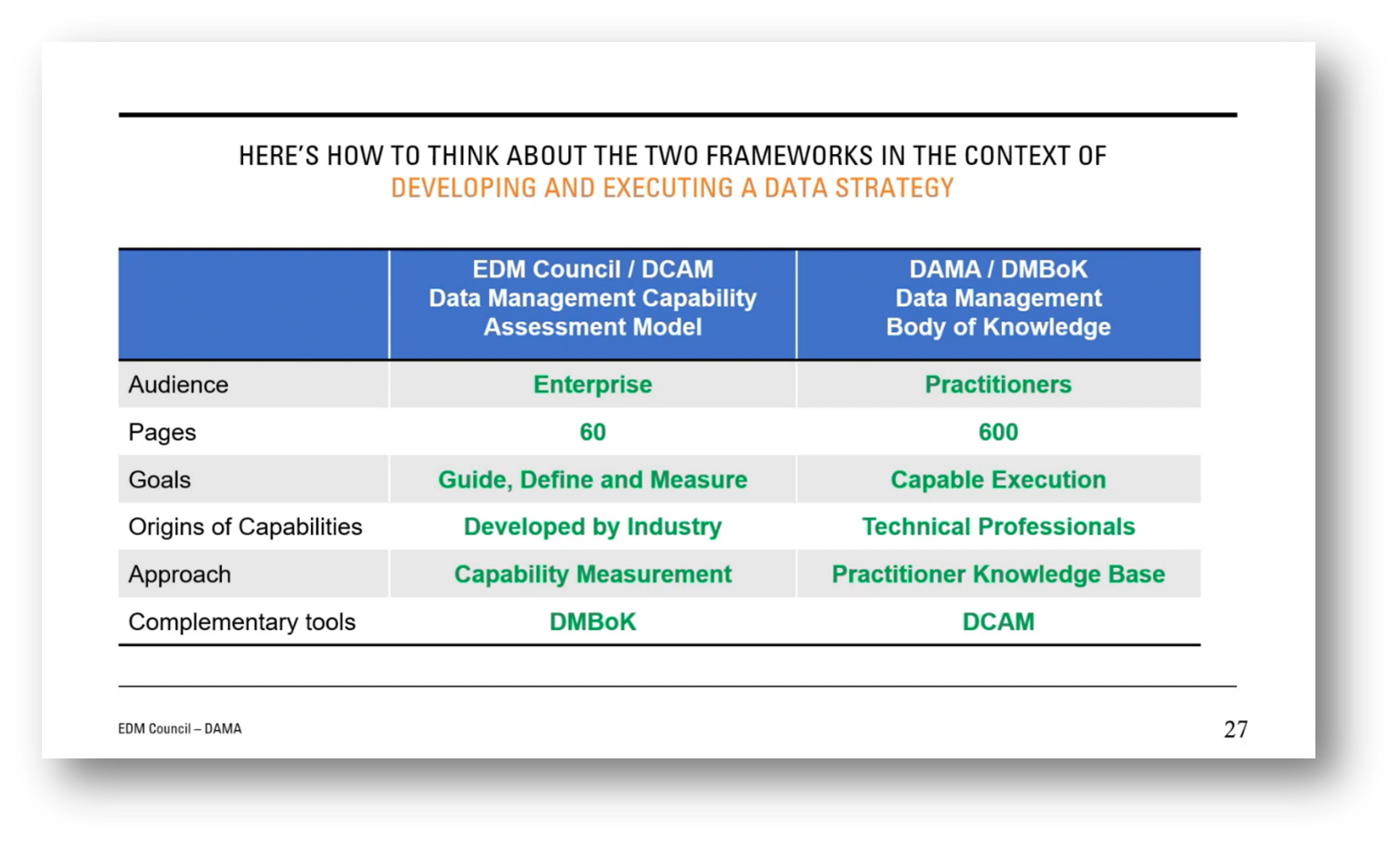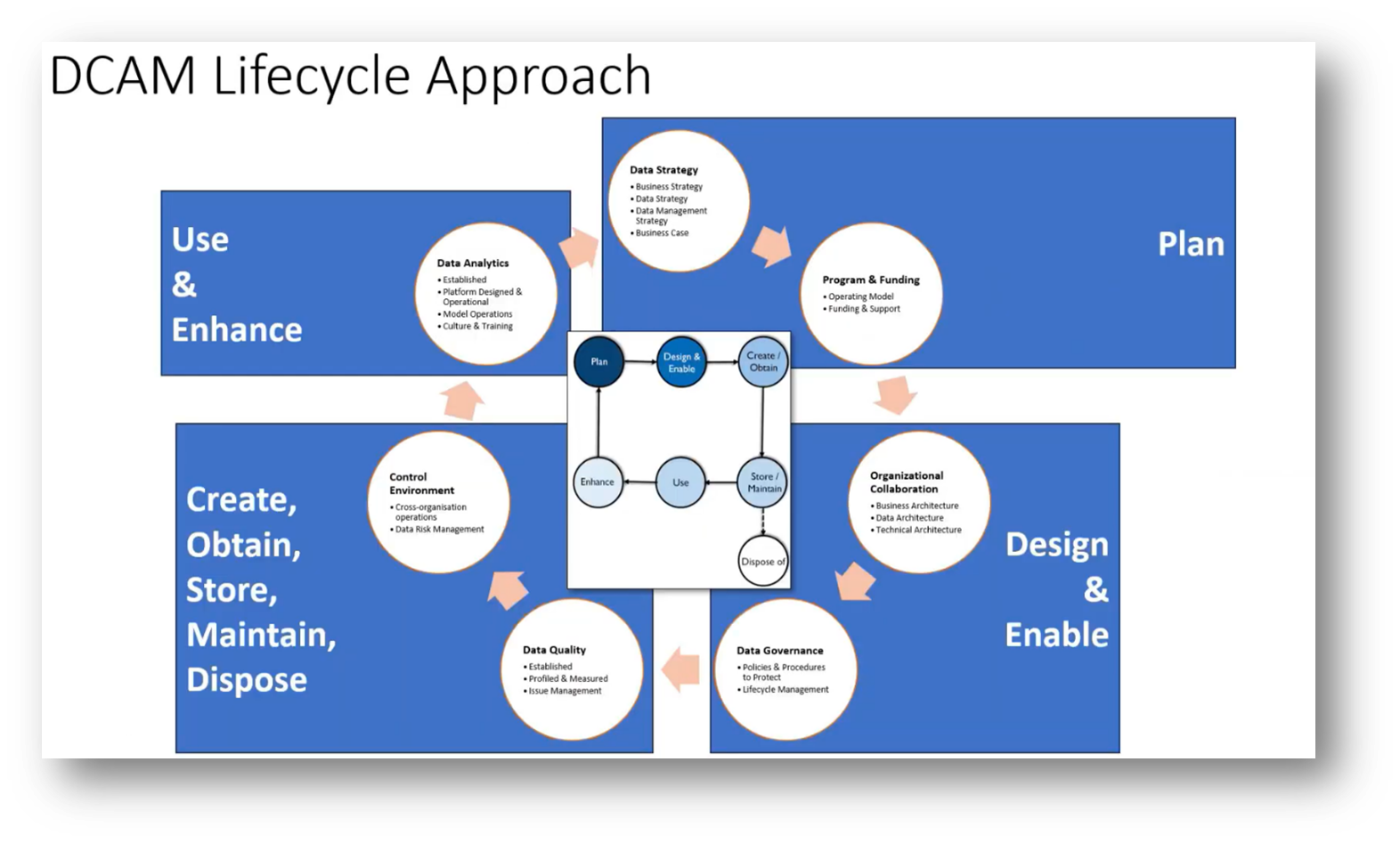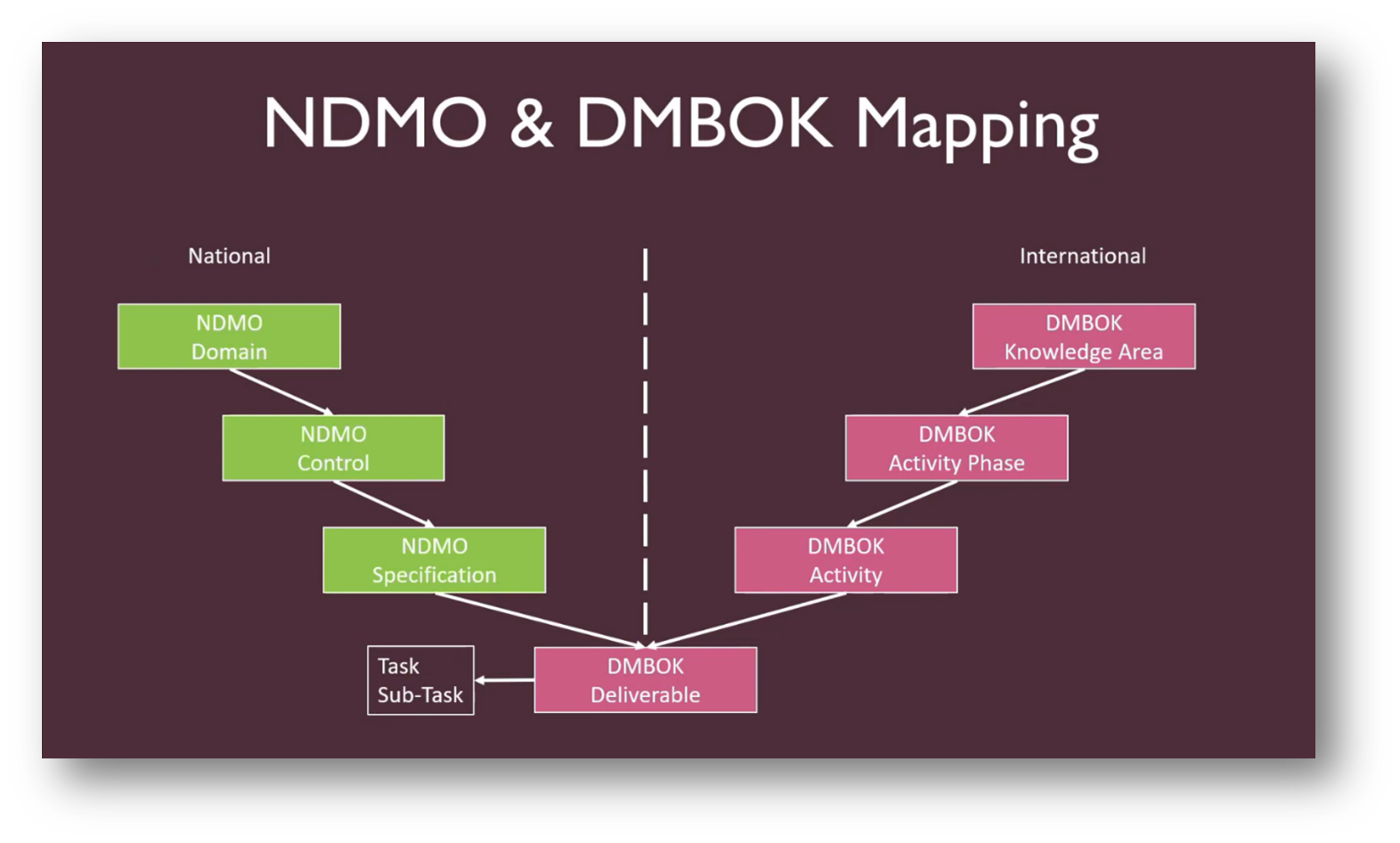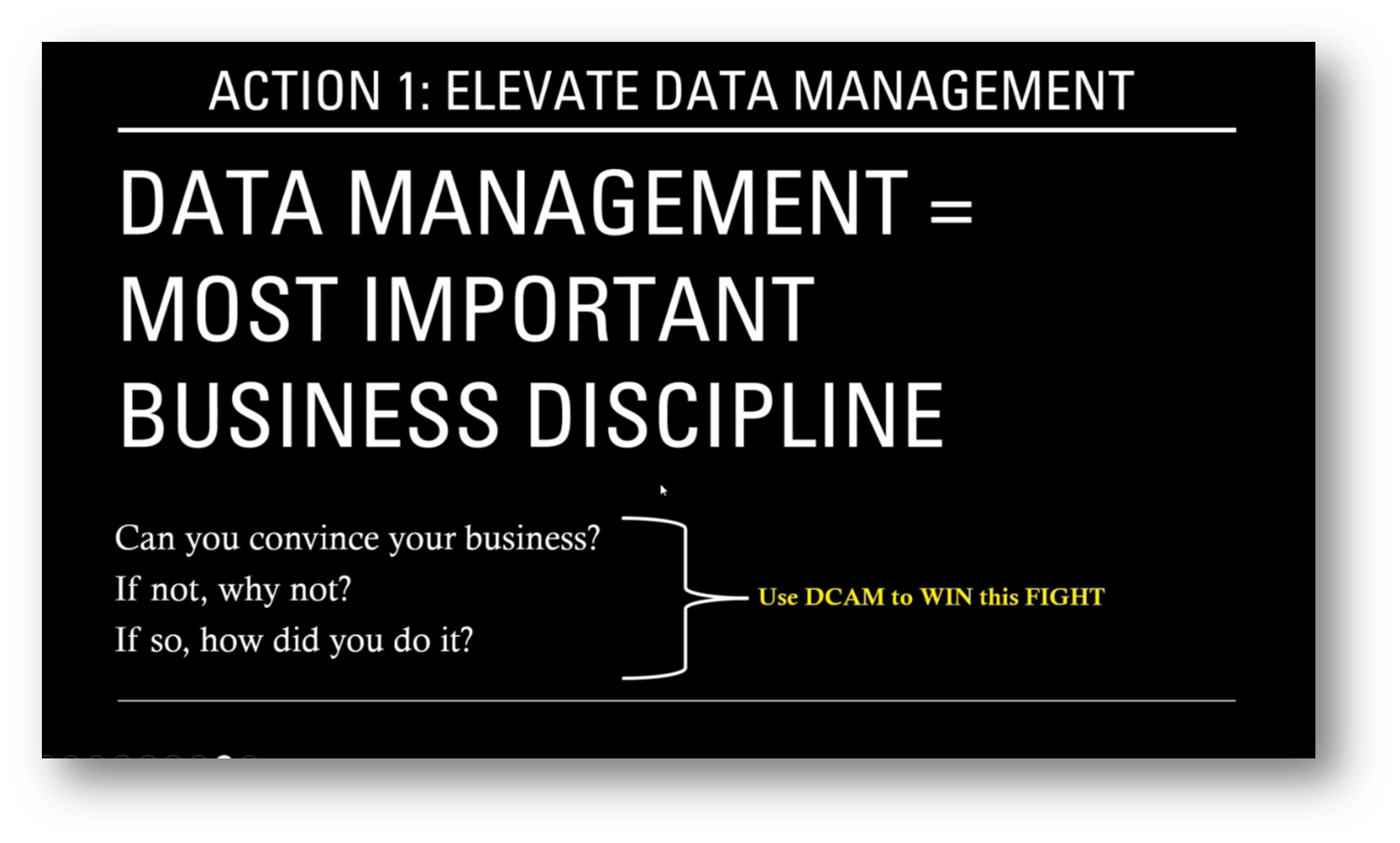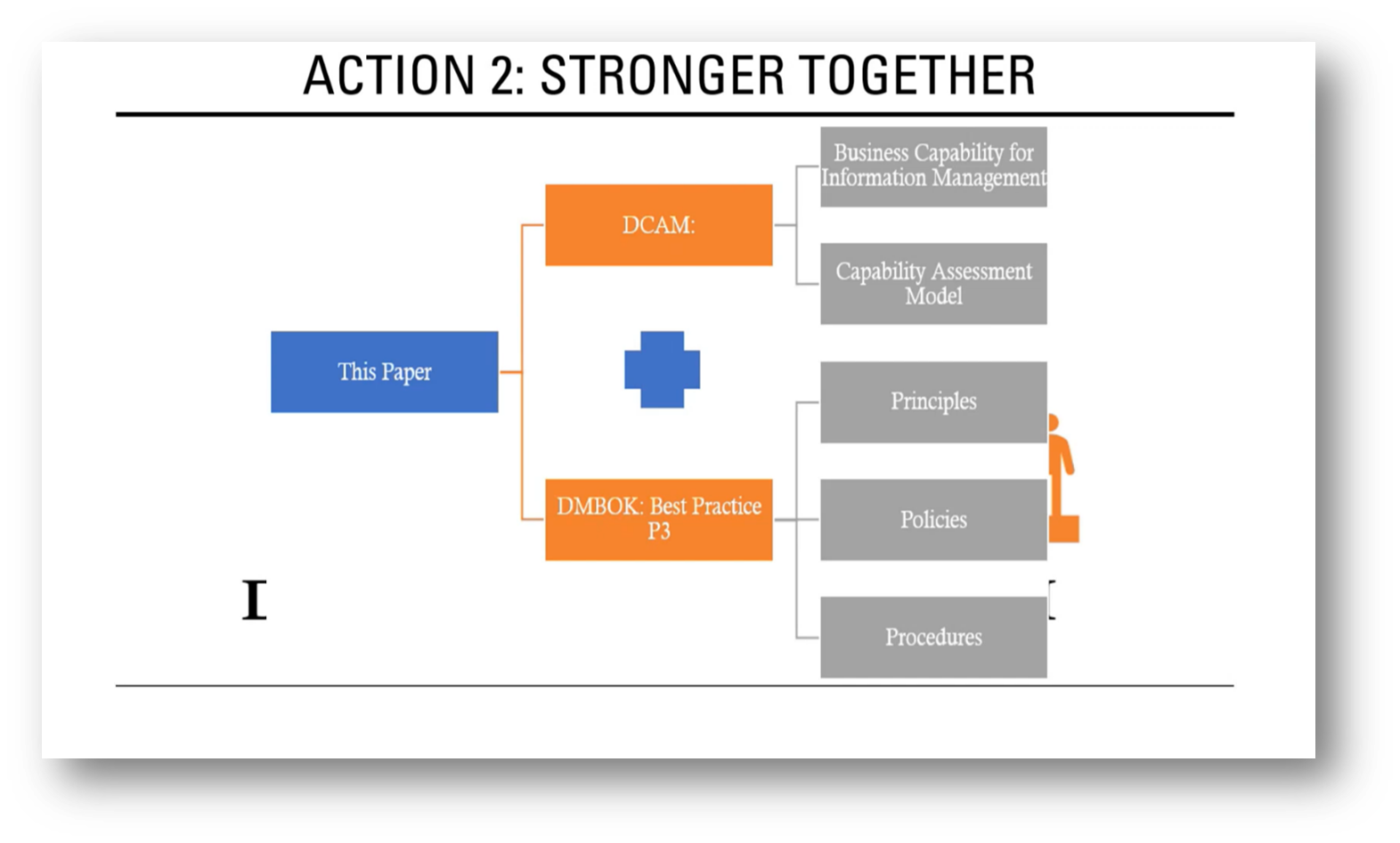Integrating DMBOK®2 & DCAM for Enhanced Data Management in AI for Data Executives
Executive Summary
This webinar summary outlines the critical role of data governance in today's data management and AI projects, emphasising the use of established frameworks like the Data Management Capability Assessment Model (DCAM) and the Data Management Body of Knowledge (DMBoK). Howard Diesel highlights their applicability across various industries and institutions, addressing how these frameworks serve as maturity assessments for data management practices.
Howard examines the differences and key factors that distinguish DCAM and DMBoK, along with their implications for corporate data management, compliance with regulations, and best practices in business architecture. The webinar discusses the integration of data management within organisational change management and the importance of these frameworks in facilitating digital transformation. Finally, it underscores global and local initiatives aimed at enhancing community engagement and collaboration in data governance and management.
Webinar Details
Title: Integrating DMBOK®2 & DCAM for Enhanced Data Management in AI for Data Executives
Date: 10/04/2025
Presenter: Howard Diesel
Meetup Group: African Data Management Community
Write-up Author: Howard Diesel
Contents
Data Management and AI Projects
The Necessity of Data Governance
Use of DCAM and DMBoK in the Data Management Landscape
DCAM and DMBoK in Use
Data Governance and Comparative Analysis of Frameworks
DCAM and DMBoK applied in Different Industries and Institutions
Frameworks as Data Management Maturity Assessments
Comparing DCAM and DMBoK Frameworks
The Role of DCAM in Corporate Data Management
Differences between Data Management Models
The Missing Factors in DCAM and Its Impact on Data Management and AI
Understanding Business Architecture
Data Management and Its Importance in Business Architecture
Understanding Different Regulations and Frameworks in Data Management
The DMBoK Framework and Its Application in Data Security
Data Management Maturity Assessment and Its Differences with DCAM
Business Architecture and Best Practices
Development of DCAM and DMBoK Frameworks
Integration of Data Management in Business
Organisational Change Management and Data Management
Data Governance in AI and Digital Transformation
Global and Local Initiatives for Data Management and Community Engagement
IT Management, Governance, and Data Management in a Collaborative Environment
Regulatory Frameworks and Data Management in Industries
Data Management and AI Projects
Howard Diesel opens the webinar and shares that his presentation focuses on integrating two frameworks, the Data Management Body of Knowledge (DMBoK) Version 2 Revised Edition and the Data Capability Assessment Model (DCAM), for enhanced data management in AI projects. He begins by addressing common misconceptions and clarifying the roles and purposes of these two frameworks.
Andrew Andrews will be assisting. Howard expresses gratitude for the support. The presentation aims to highlight the benefits of using both frameworks in tandem, offering practical insights into AI applications. Howard and Andrew have prepared a draft for submission to EDW and welcome feedback for improvement, with additional content, including prodigal slides, to be incorporated later.
Figure 1 Cover Image
Figure 2 Abstract
The Necessity of Data Governance
The challenges associated with managing various types of governance in data management are highlighted, including data governance, AI governance, data privacy governance, and digital transformation governance. Howard emphasises the need for a unified approach to governance, arguing that segregating these responsibilities can lead to overlapping structures, a lack of clear decision-making, and fragmented mandates. Additionally, the concern is that the introduction of new regulations often results in the establishment of additional departments, further complicating governance instead of promoting a cohesive framework.
Figure 3 Framework Integration Deck
Figure 4 "Introduction"
Use of DCAM and DMBoK in the Data Management Landscape
Howard highlights key statistics regarding the usage of DCAM and DMBoK frameworks among enterprises, with 19.25% utilising both, 31% not using either, 22% using only DCAM, and 27% using only DM Bach. He then emphasises the significance of addressing the substantial percentage of users who are not engaged with either framework, seeing it as an opportunity for growth within the community. Additionally, Howard acknowledges the challenges ahead in promoting these frameworks to data management enterprises but expressed optimism about the potential for positive change and improvement in the market.
Figure 5 Research Insights
DCAM and DMBoK in Use
The surprising findings from research conducted by Anthony Mazzarella regarding the use of frameworks across different industries, particularly noting that the finance and insurance sectors average only 1.25 frameworks, which is unexpectedly low compared to healthcare and life sciences.
Mazzarella’s figure raises questions about the effectiveness and innovation within the highly regulated finance sector, which is on par with education and nonprofit fields. Additionally, Attendees express curiosity about the potential influences of government regulation and legacy technology on these numbers as they ponder the lack of clarity in the trends observed across industries.
Figure 6 Research Insights Pt.2
Figure 7 Research Insights Pt.3
Data Governance and Comparative Analysis of Frameworks
In a recent online discussion regarding data governance frameworks, various frameworks such as ISO 8000 and DGID were compared, highlighting the significant presence of non-numerical frameworks (NoNs). Howard notes that the analysis revealed that frameworks like DMBoK show a noteworthy prominence in sectors like trade and retail, though the specific categorisations remain unclear.
A key observation was the absence of oil and gas data within the classifications, prompting a follow-up with Tony to clarify their inclusion. Overall, the figures indicated that while there are gaps in implementation, there remains a substantial opportunity for improvement and further development in data governance practices.
Figure 8 Research Insights Pt.4
DCAM and DMBoK applied in Different Industries and Institutions
The discussion highlights the lack of standardised frameworks in the education and nonprofit sectors. A significant 76% of organisations reportedly use customised methods instead of established frameworks, as reflected in a PMI report indicating that 78% of organisations prefer tailored frameworks. In contrast, the finance and insurance industries demonstrate a greater adoption of frameworks like D-CAM.
An attendee notes that higher education is slowly beginning to embrace these concepts, with many professionals coming from within the institution rather than the corporate world. There is also a tendency for organisations to stick with either D-CAM or DM-BOK frameworks, as evidenced by the tribal-like divisions among practitioners, which complicates the cross-adoption of methodologies. Overall, the conversation suggests that frameworks in education are still evolving, with a notable gap in understanding and application compared to other sectors.
Figure 9 Research Insights Pt.5
Figure 10 Research Insights Pt.6
Figure 11 Misconceptions
Figure 12 "Are the EDM Council & DAMA competing organisations?"
Frameworks as Data Management Maturity Assessments
Howard moves on to focus on the differences between the DCAM and DMBoK frameworks, highlighting common misconceptions about data management maturity assessments, such as those from TDWI or Gartner. It addresses the notion that having a maturity assessment eliminates the need for DCAM, emphasising instead that DCAM should be viewed as a tool for diagnosing an organisation's data capability health, which encompasses data literacy and awareness, rather than merely assessing systems. The conversation also touches on the importance of cultural understanding in data management.
Figure 13 "Are the DCAM & DMBoK competing frameworks?"
Comparing DCAM and DMBoK Frameworks
Comparing the DCAM and DMBoK frameworks presents challenges, particularly regarding their approach to data management maturity assessments. DCAM, represented visually with concentric circles, emphasises the importance of business cases and operating models regardless of the data type—be it reference, master, or transactional data.
Howard notes that while some comparisons omit aspects like data security, DCAM actually encompasses data modelling, architecture, and business architecture within its capabilities. Additionally, Dr. Irina Steenbeck's analysis reveals that many comparisons mistakenly equate different frameworks, leading to confusion about their distinct focuses and functionalities.
Figure 14 DMBoK Wheel Vs. DCAM Frisbee: Comparison
Figure 15 Dimensions & Characteristics of Frameworks
Figure 16 Different View of the Position of the Frameworks
The Role of DCAM in Corporate Data Management
While DCAM establishes data and information management as essential business capabilities and provides a capability assessment model, DMBOK focuses on the underlying principles and practices of data management, addressing the "why" and "what" rather than the "how" of implementation.
Many large corporations express confusion about how DCAM fits into their existing DMBOK frameworks, often questioning the need for DCAM at an enterprise level when they already utilise DMBOK. The aim is to clarify these concepts and foster a better understanding of their complementary roles in effective data management.
Differences between Data Management Models
Melanie Mecca's work highlighted the misalignment between the Data Management Maturity (DMM) and the Capability Maturity Model Integration (CMMI) frameworks, emphasising their different structural approaches: DMM serves as a scope-based yardstick, while DCAM takes a lifecycle perspective to assess practices at various stages.
Howard notes that Mecca advises that those transitioning from CMMI to DMM should focus on mapping work products or artefacts from both models to clarify their integration, as this would help eliminate confusion. He adds that, overall, both models align in terms of policies, processes, and standards, underscoring the significance of data products in data management practices.
Figure 18 CMMI DMM to DCAM Mapping
The Missing Factors in DCAM and Its Impact on Data Management and AI
The absence of reference and master data within the DCAM framework raises concerns. While the framework doesn't explicitly label elements as reference and master data, it encompasses essential components like data quality, integration, policies, and procedures necessary for effective management. Additionally, the DCAM lifecycle adequately addresses data modelling, documentation, and security without needing a separate designation.
While some critics point out missing elements in data management strategy and technology architecture, Howard notes that the framework does discuss the importance of these aspects within its overall data governance and management strategy. The data architecture is broad enough to include all knowledge areas within the DMBoK, ensuring comprehensive data management.
Figure 19 CMMI DMM to DCAM Mapping
Figure 20 DCAM: Missing Elements
Figure 21 DCAM: Missing Elements Pt.2
Understanding Business Architecture
The business architecture encompasses various areas and capabilities that identify the stakeholders, both internal and external to the organisation, highlighting the value propositions delivered to them. Value propositions can be mapped to value streams, reflecting the steps taken to achieve customer experience and other outcomes. Key components include business capabilities, as detailed in the Bizbok (Business Architecture Body of Knowledge), and discipline dimensions such as best practices and implementation frameworks, which are covered in the DMBoK (Data Management Body of Knowledge). These resources provide essential guidelines and assurance for implementing effective data management processes, helping individuals navigate the complexities of data stewardship and literacy before engaging with the more comprehensive DMBoK.
Figure 22 "Bringing it ALL Together"
Data Management and Its Importance in Business Architecture
DCAM plays a crucial role in understanding business capabilities related to data management, emphasising its significance as a horizontal capability that spans all business verticals. While other maturity assessments like TDWINDI and Gartner focus on evaluating data management as a practice, DCAM emphasises delivering value to stakeholders and aligning with business architecture.
The EDM Council enhances this perspective by benchmarking capabilities globally across various industries, highlighting the necessity of executive recognition for effective data management. As AI advances, organisations must acknowledge data dependencies to harness its full potential, making the distinction between these assessments essential for understanding their complementary roles in driving business value.
Figure 23 "Bringing it ALL Together" Pt.2
Understanding Different Regulations and Frameworks in Data Management
Howard moves on to the various regulations and frameworks relevant to business and data architecture, particularly in Saudi Arabia. Key components include the National Office of Reference Architecture (NORA), which parallels TOGAF, and the National Data Management Office (NDMO), alongside ISO standards and NIST's AI risk management framework, which assists in understanding AI risks.
Industry reference models such as Bizbok cater to diverse sectors like healthcare and finance, while government information management capabilities are less impactful than the DCAM. The landscape in Saudi Arabia features multiple frameworks like NDI and AI enablement, and organisations like DGA require adherence to these standards, highlighting the complexity and breadth of frameworks in use. This situation contrasts sharply with the average framework usage elsewhere, underscoring the extensive compliance demands Saudi ministries face.
Government entities are increasingly adopting and customising international standards frameworks, such as the DMBoK and the NDMO framework, to develop their national frameworks. For instance, India has created its National Data Index, which addresses gaps in innovation. It's important to distinguish between regulations, like the NDMO in Saudi Arabia, and standards, as the DMBoK focuses on the "why" and "what" behind data management without addressing the value proposition. The D-CAM framework complements this by assessing the necessary capabilities to establish and sustain data management practices. A common challenge is that business stakeholders often perceive these frameworks as merely IT practices, leading to a disconnect where they feel it's unnecessary to engage with or understand the underlying principles of data management.
Figure 24 "Bringing it ALL Together" Pt.3
Figure 25 "Bringing it ALL Together" Pt.4
Figure 26 DMBoK and DCAM: Clarification
The DMBoK Framework and Its Application in Data Security
The DMBoK framework serves as a guide for understanding the scope of reference and master data disciplines but does not provide specific processes for implementation, particularly regarding technology such as Informatica or Calibra. It emphasises the conceptual aspects of data management rather than how to enforce data security through various technologies.
While the DMBoK helps in understanding practices and their maturation, it does not refer to reference and master data directly. Practitioners should approach frameworks carefully, recognising that they offer a set of techniques to adapt rather than strict implementation guidelines. Personalising policies and procedures based on the DMBoK framework is encouraged to suit specific organisational needs.
Figure 27 One-line Definition
Data Management Maturity Assessment and Its Differences with DCAM
Chapter 15 of the DMBoK focuses on data management maturity assessment, highlighting the difference between the DMBoK and DCAM. While the DMBoK can serve as a framework for assessing knowledge areas and practices related to data management, it is not a sustainable assessment model nor a checklist, unlike DCAM, which provides an industry-specific checklist for assessing maturity.
The DMBoK allows organisations to create bespoke assessments but does not benchmark against others, which can lead to confusion. It is particularly useful for organisations at lower maturity levels, while advanced practitioners may require more structured tools like DCAM to develop effective data management practices within their specific industries.
A discussion starts on the advantages of using DCAM over DMBoK for establishing data management benchmarks. Howard emphasises that DCAM's authoritative guidance on required capability levels is noted, as it offers standardised questions and advice to assess and improve data management practices. Additionally, DCAM provides clearer direction for maturity assessments.
Howard and the attendees agree that DCAM effectively outlines the necessary capabilities for specific use cases, facilitating a more structured approach compared to relying solely on the assessor's insights with DMBoK. Overall, he and the attendees reach a consensus that the DCAM is the preferred framework for achieving desired levels of data maturity and management effectiveness.
Figure 28 DMBoK Chapter 15
Figure 29 DMBoK & DCAM Positioning
Business Architecture and Best Practices
Howard highlights the interconnectedness between DCAM and the Data Management disciplines, emphasising the need for alignment at both the executive business capability level and the practitioner level. It contrasts the two frameworks, noting that while DCAM contains 60 pages focused on guiding business capabilities and maturity assessment, DMBoK extends to 600 pages, providing practical execution guidance. Howard then reflects on previous challenges in demonstrating the value of these frameworks to enterprise architecture, underlining the importance of both perspectives for effective data management and architecture within organisations.
Development of DCAM and DMBoK Frameworks
The DMBOK (Data Management Body of Knowledge) was developed by thought leaders like Steve Hoberman and John Ladley, who wished to emphasise the importance of a life cycle approach to data management. Key capabilities of the DCAM include data strategy, management, programming, funding, collaboration, governance, quality control, and analytics.
Effective planning and collaboration are crucial before implementing analytics. While DCAM requires a holistic approach, the DMBoK allows for focused engagement on specific areas such as reference and master data. Linking DCAM assessments to DMBoK deliverables facilitates the integration of both frameworks, ensuring that tasks outlined in NDMO specifications can be effectively addressed by corresponding DMBoK resources.
Figure 30 "Combined Benefits"
Figure 31 Integration Benefits
Figure 32 Developing and Executing a Data Strategy
Integration of Data Management in Business
To elevate data management as a critical business discipline, it is essential to leverage frameworks such as DCAM and DMBOK. While DCAM represents the high ground in data management capabilities, DMBOK serves as a foundational resource that aligns with the necessary practices within organisations.
Integrating both models can facilitate a comprehensive approach to managing data, including aspects like data literacy, which falls under organisational change management and data governance. This dual-framework strategy helps address challenges related to resource limitations and prioritisation in implementing data management practices, enabling organisations to effectively assess their needs and embark on a strategic path forward.
Figure 33 DCAM Lifecycle Approach
Figure 33 DCAM Lifecycle Approach
Figure 35 NDMO & DMBoK Mapping
Figure 36 "Call to Action"
Organisational Change Management and Data Management
The relationship between change management and data management within organisations is highlighted in the context of evolving business capabilities. Howard references the theme book' Chapter 17, noting that while change management is essential for implementing data management frameworks, it often lacks practical application in the data domain.
The DMBoK emphasises the necessity of change management for fostering a data culture, yet debates exist regarding its standalone status compared to project management. Overall, the conclusion is that while organisational change management should not be viewed as a separate data management practice, it remains a critical organisational capability that must be acknowledged in the pursuit of effective data management.
Data Governance in AI and Digital Transformation
The discussion highlights a significant challenge in enterprise data architecture stemming from a lack of dedicated roles to bridge the gap between business and data management. The need for a business data management architect, who would provide a comprehensive roadmap over two to three years, outlining the implementation of projects aligned with business capabilities, is emphasised. This role is crucial for managing the complexities of enterprise architecture, which spans both IT and business architecture. As enterprise architecture is often perceived solely as an IT function, there is a pressing need to integrate business architecture and process architecture into the framework. The success of an enterprise data architect hinges on having clear direction and an established roadmap, which is currently lacking, thus complicating their ability to focus on building a robust enterprise-wide data model and meeting business demands.
The discussion emphasises the importance of establishing a unified data governance framework encompassing all forms of data, including both structured and unstructured data, rather than maintaining separate governance for records management, information governance, and data governance. It highlights the crucial role of data management in driving digital transformation and enabling effective data analytics, forecasting, and decision-making. By integrating data governance with AI and ensuring that systems are designed to leverage data responsibly, organisations can harness insights for strategic decision-making while mitigating risks associated with digital systems.
Figure 37 Elevate Data Management
Figure 38 Action 2: Stronger Together
Global and Local Initiatives for Data Management and Community Engagement
Howard highlights the three key action points regarding data management best practices, emphasising the provision of a high-level mapping between the DM Bock and DCAM, available upon request. While deploying an in-house data management instrument based on the DMBoK is encouraged to establish a baseline, it is deemed unsustainable in the long term.
IT Management, Governance, and Data Management in a Collaborative Environment
A discussion on the complexities faced by practitioners in IT management and governance highlighted the challenges of orchestrating different knowledge areas within data management and governance. Howard emphasises the need for a holistic approach to governance, as various work streams often operate in silos, making it challenging to effectively sequence tasks necessary for successful data strategy implementation.
Howard and Attendees also addressed the lack of guidance in the DMBoK, particularly regarding coordinating efforts across different areas. Howard suggests that methods like the "crawl, walk, run" framework could be beneficial. Additionally, the importance of developing meaningful KPIs within this vast landscape is underscored, alongside a proposal for collaboration to explore the integration of these concepts in the upcoming version of DM BoK.
Lastly, the importance of selecting meaningful KPIs for measuring organisational performance is highlighted, particularly through the lens of the DCAM. Howard emphasises differentiating between business KPIs, which reflect value creation and should be on the rise, and data office ROI, focusing on the effectiveness of the data office itself.
Regulatory Frameworks and Data Management in Industries
The importance of understanding information concepts at the business architecture level versus data architecture is highlighted, and the link between business capabilities and data management is recognised as a vital aspect for building effective data strategies. Additionally, Howard notes that while DCAM focuses primarily on data management aspects and references training and operational models, it does not comprehensively address all business functions, like sales and marketing. He adds mapping efforts to connect these data management processes with broader business perspectives, emphasising the importance of information management across all business capabilities.
If you would like to join the discussion, please visit our community platform, the Data Professional Expedition.
Additionally, if you would like to be a guest speaker on a future webinar, kindly contact Debbie (social@modelwaresystems.com)
Don’t forget to join our exciting LinkedIn and Meetup data communities not to miss out!
